Disease
English |
Disease
French |
Agent |
Status in UNECE
Standard |
Recommended
diagnostic method |
General disease
description |
Tuber symptom |
Plant syptoms |
Comment |
| |
|
|
|
|
|
|
|
|
| FUNGUS |
| |
|
|
|
|
|
|
|
|
| Potato wart disease |
Galle verruqueuse |
Synchytrium endobioticum |
Zero tolerance |
Visual observation of tubers and stem base |
Tuber: tumours
Plant: tumours and galls on stolons and stem base |
 |
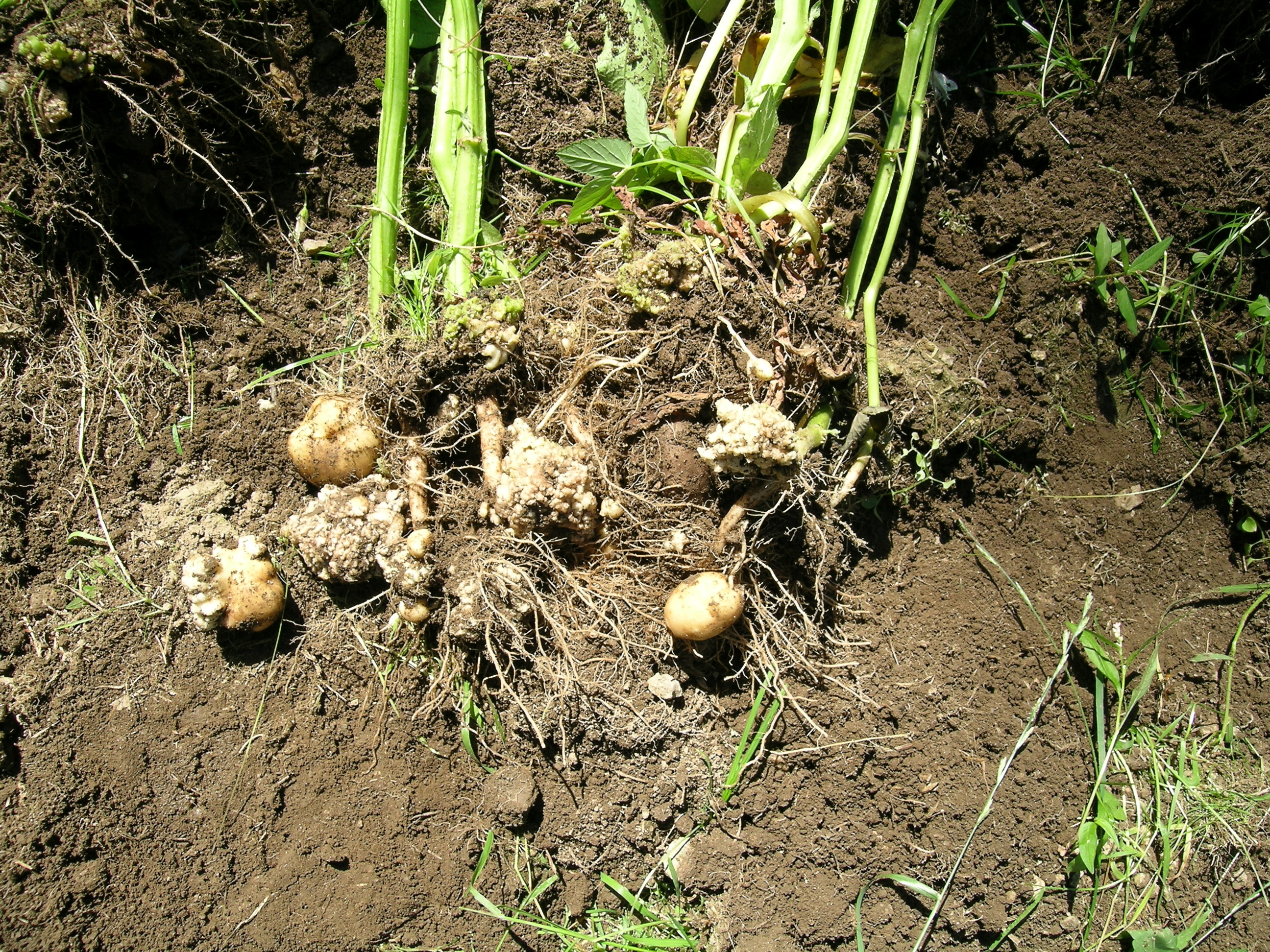 |
|
| Late blight |
Mildiou |
Phytophthora infestans |
Tolerance for wet or dry rot |
Visual observation of plants and tubers |
Tuber: rot at harvest and in storage. A reddish-brown granular rot develops under the skin into the centre of tubers.
Plant: necrosis of leaves and stems. Stem lesions of late blight resulting in stem cracking. |
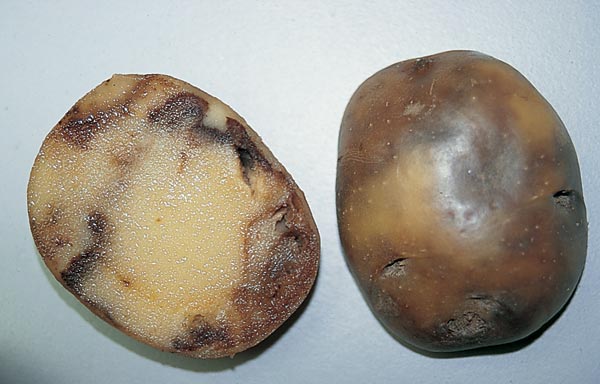
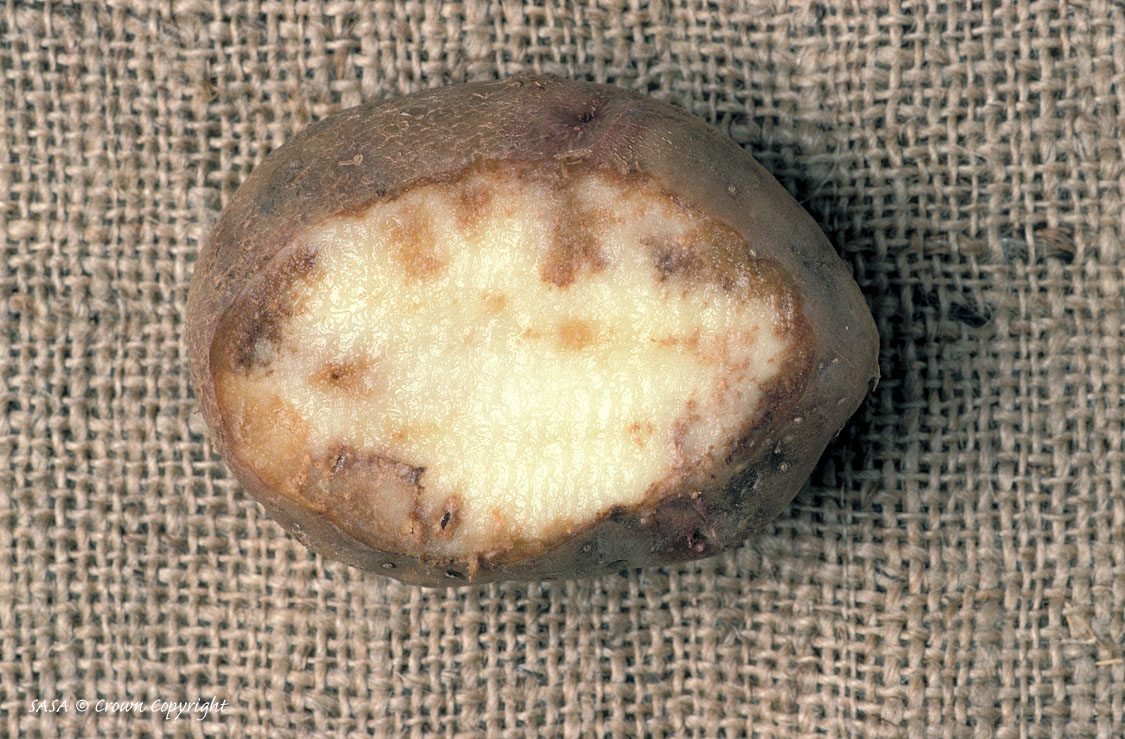 |
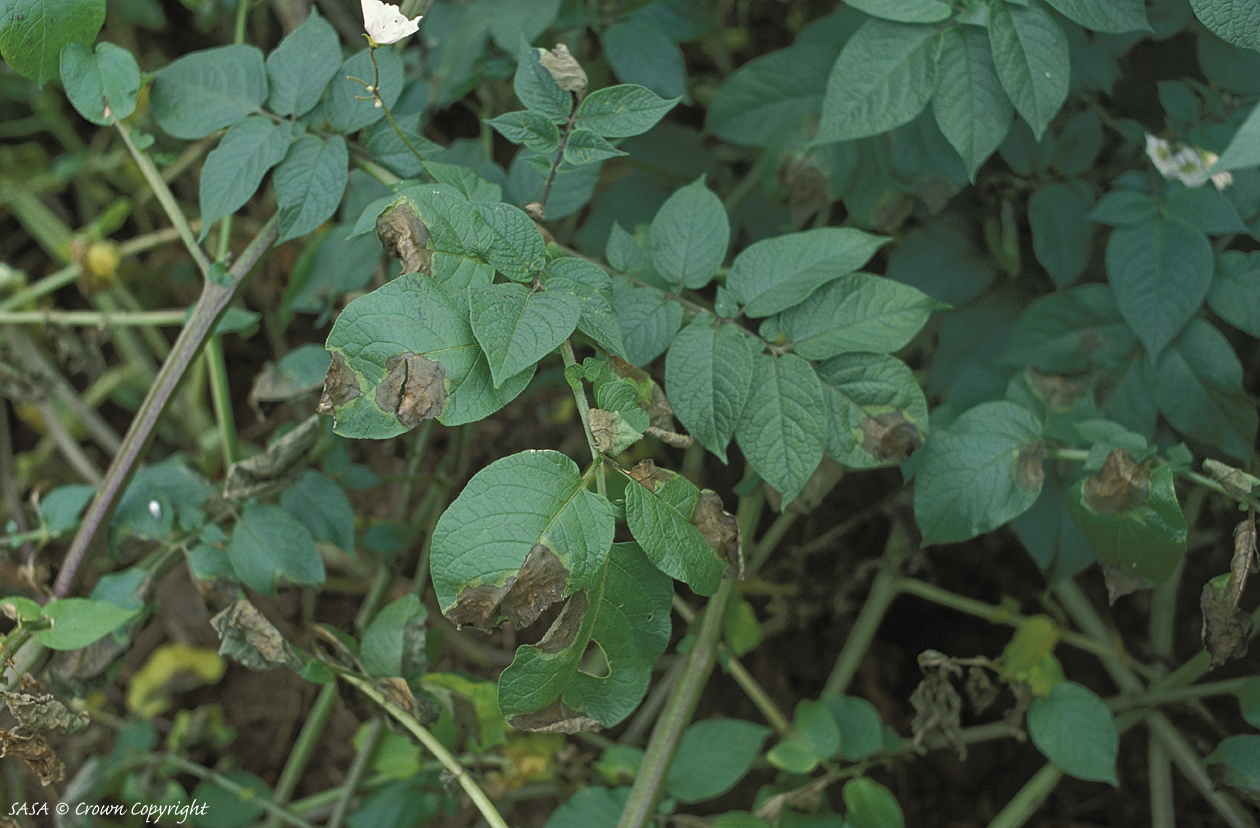
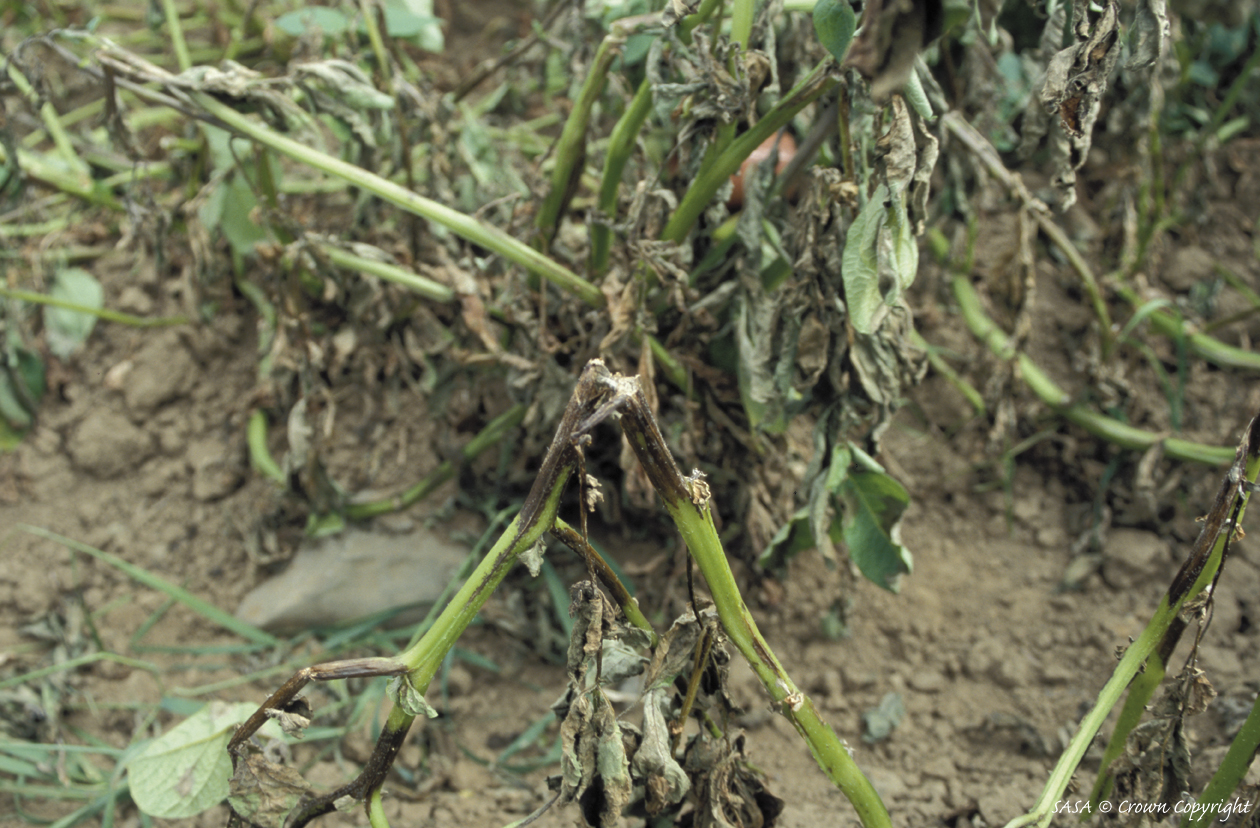
 |
|
| Dry rot |
Fusariose |
Fusarium solani var.
coeruleum |
Tolerance |
Visual observation of tubers and identification on specific medium |
Tuber: storage rot.
Circular rot with concentric wrinkles and white, orange or blue mycelial growth on surface of rot.
Light brown rot with a diffuse edge develops from skin inwards.
Plant: non-emergence or weak plants |
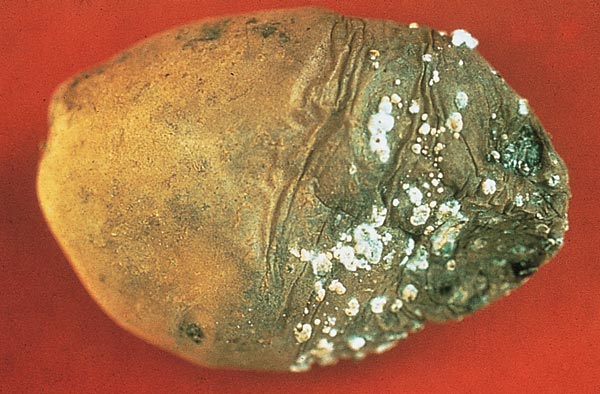
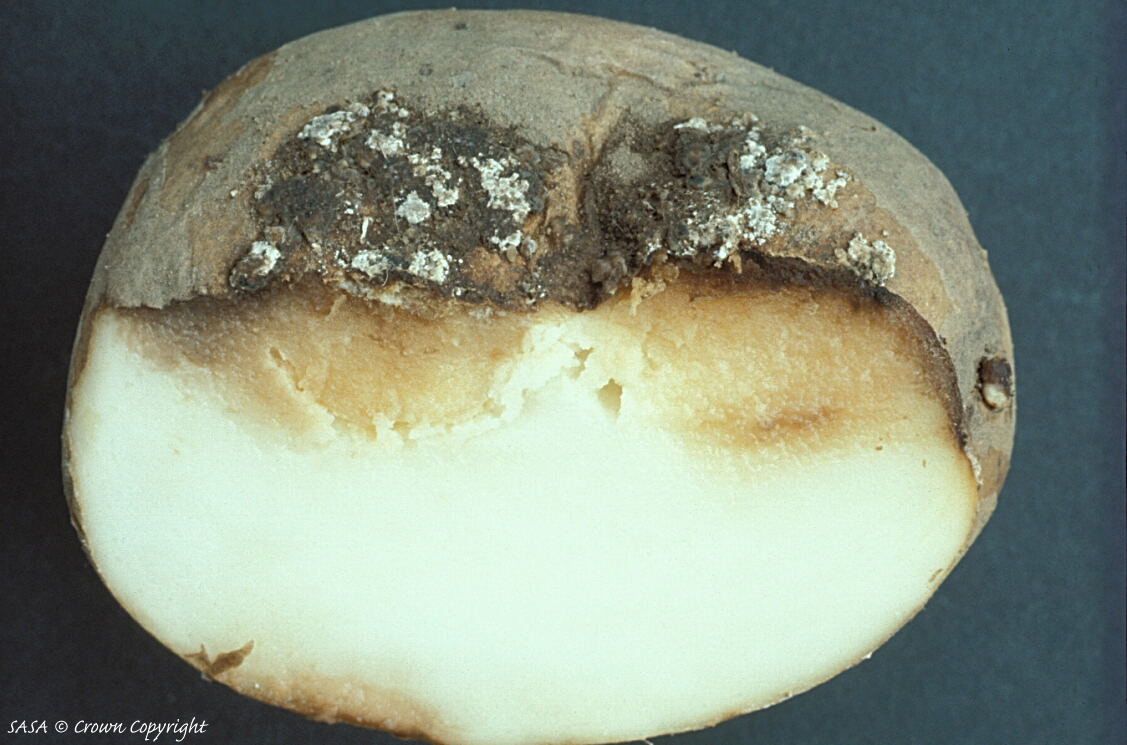 |
|
|
| Dry rot |
Fusariose |
Fusarium sulphureum |
Tolerance |
Visual observation of tubers and identification on specific medium |
Tuber: storage rot.
Small lesions develop at wounds and expand producing symptoms externally similar to gangrenei.e. slighty depressed with a wavy edge. Internally lesions develop cavities filled with grey powdery tissue.
Plant: non-emergence or weak plants |
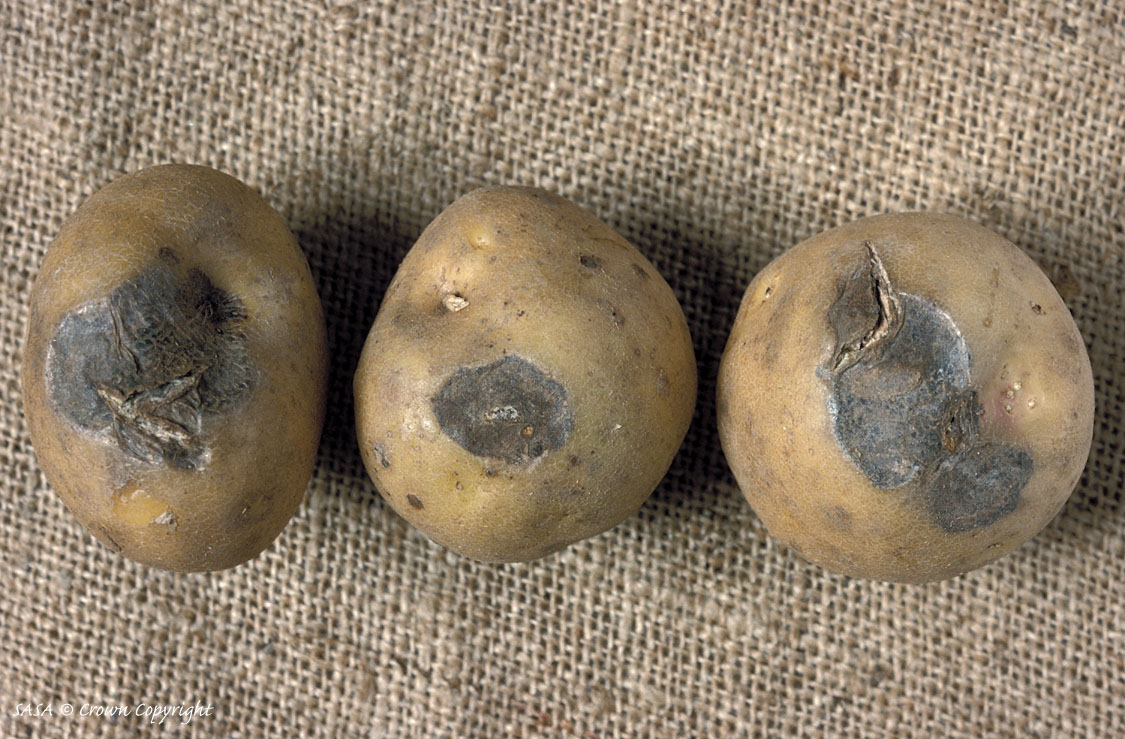
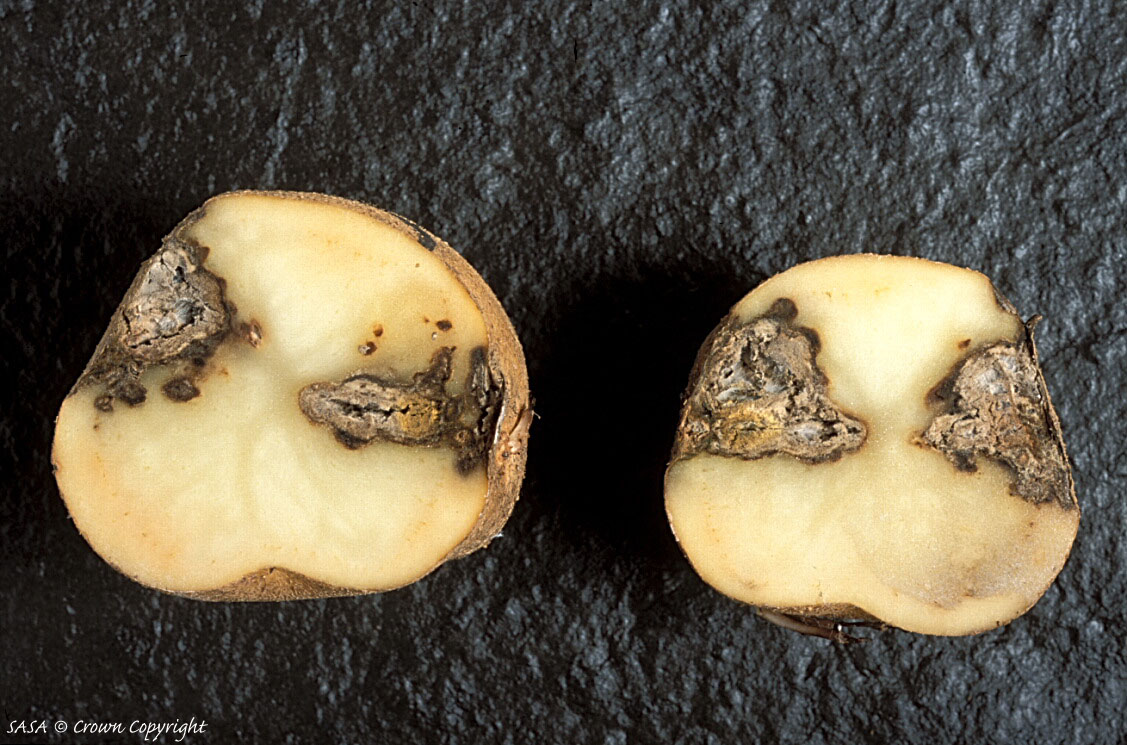 |
|
|
| Dry rot |
Fusariose |
Fusarium avenaceum and other F. spp |
Tolerance |
Visual observation of tubers and identification on specific medium |
Tuber: storage rot. Symptoms tend to be similar to those for F.solani var. coeraleum although rots are often smaller and affected tissue is dark brown as illustrated for F.avenaceum
Plant: non-emergence or weak plants |
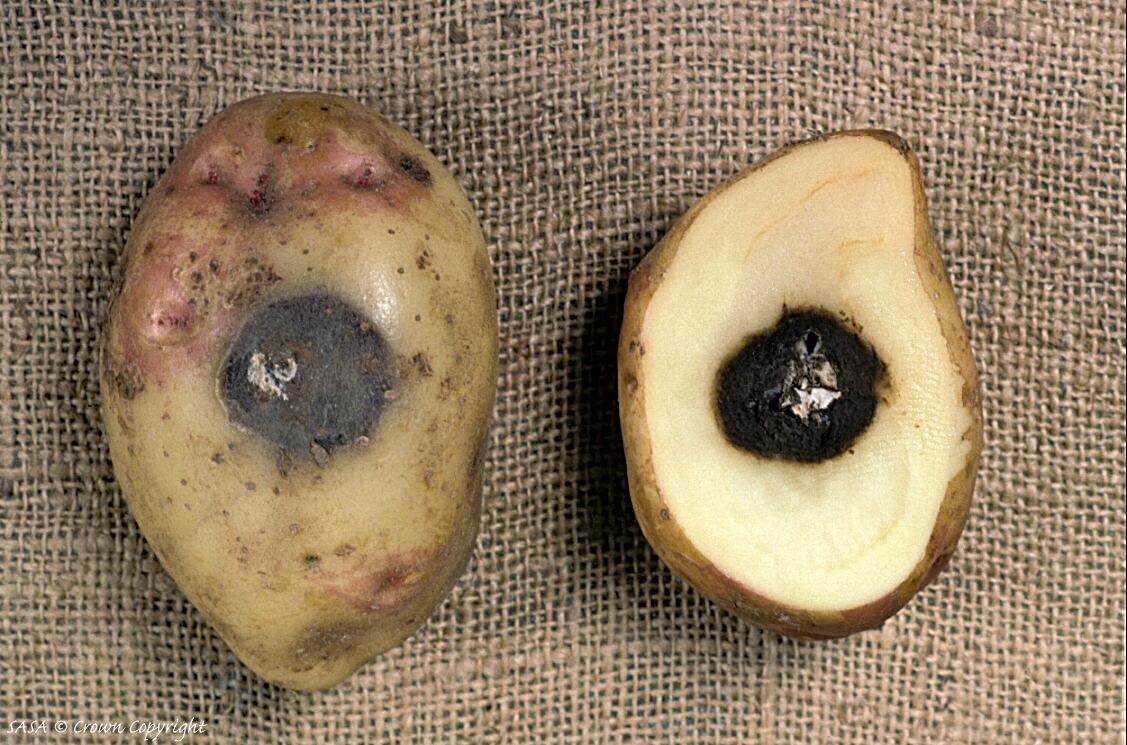 |
|
|
| Gangrene |
Gangrène |
Phoma foveata and other Phoma spp. |
Tolerance for dry rot |
Visual observation of tubers and identification on specific medium |
Tuber: storage rot. Initial lesions are round, dark and slightly depressed, often like a thumb mark. As lesions develop they become black and sunken with an irregular wavy edge. Black pycnidia can form on the surface. Rotted tissue is generally brown or black with a well defined margin between healthy and diseased tissue. Cavities are usually lined with purple, yellow or white mycelia.
Plant: non-emergence or weak plants |
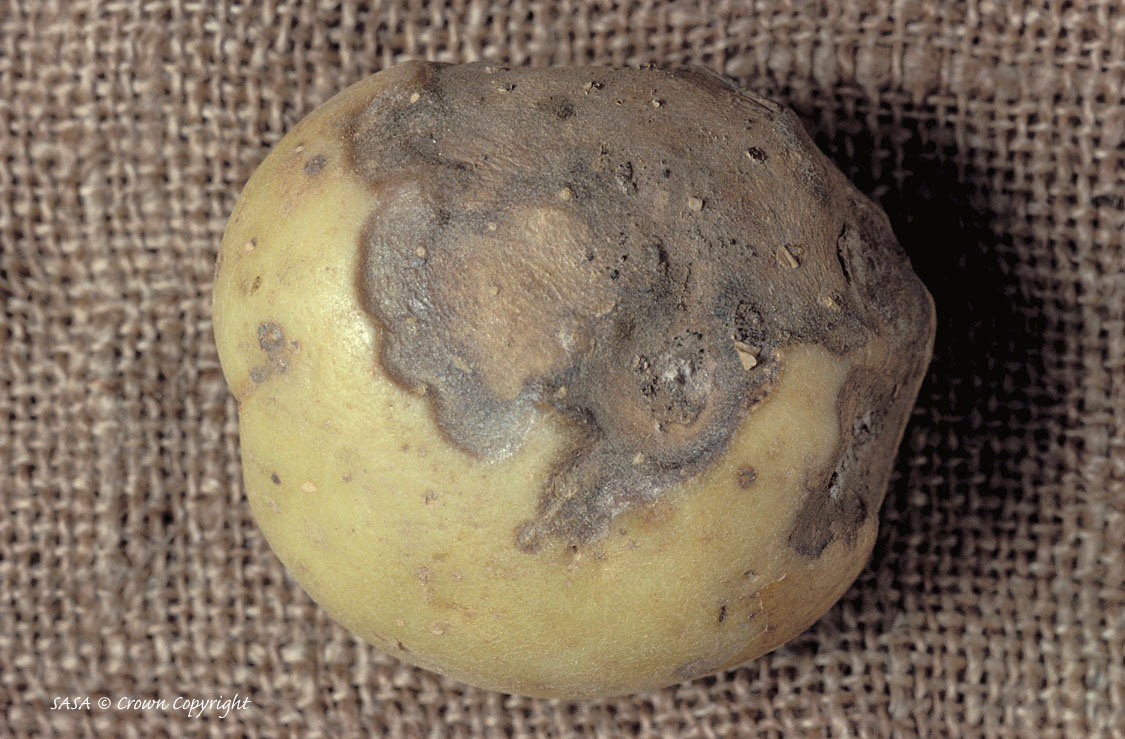
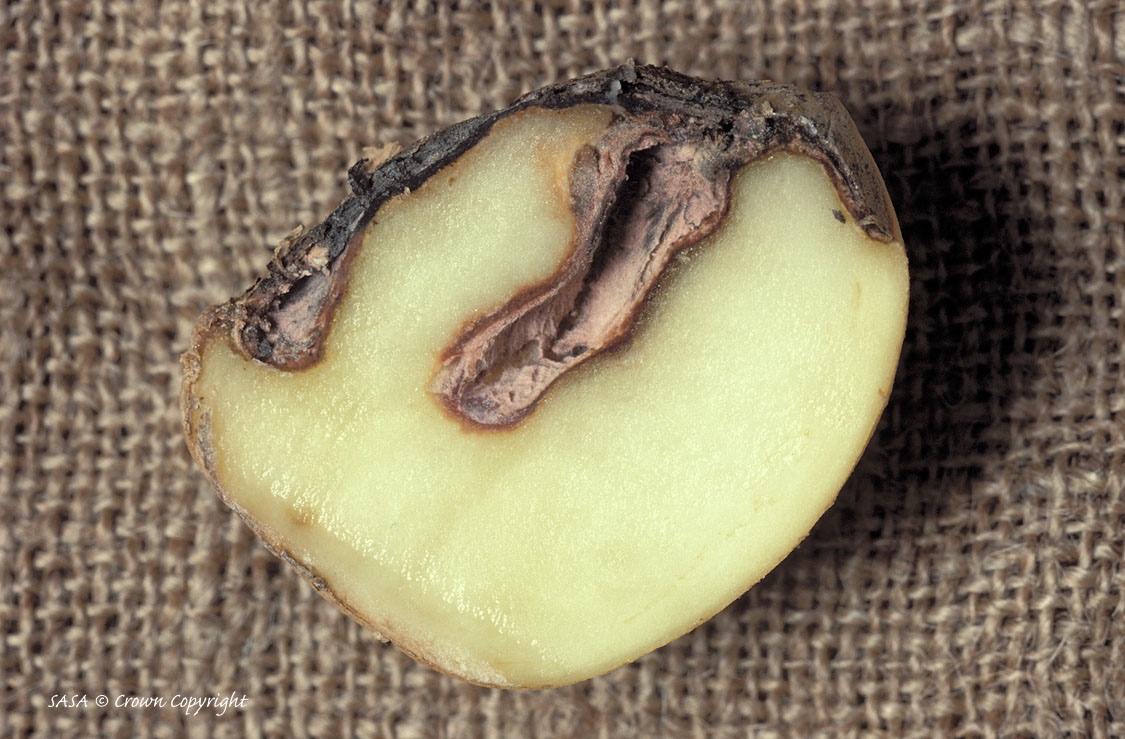

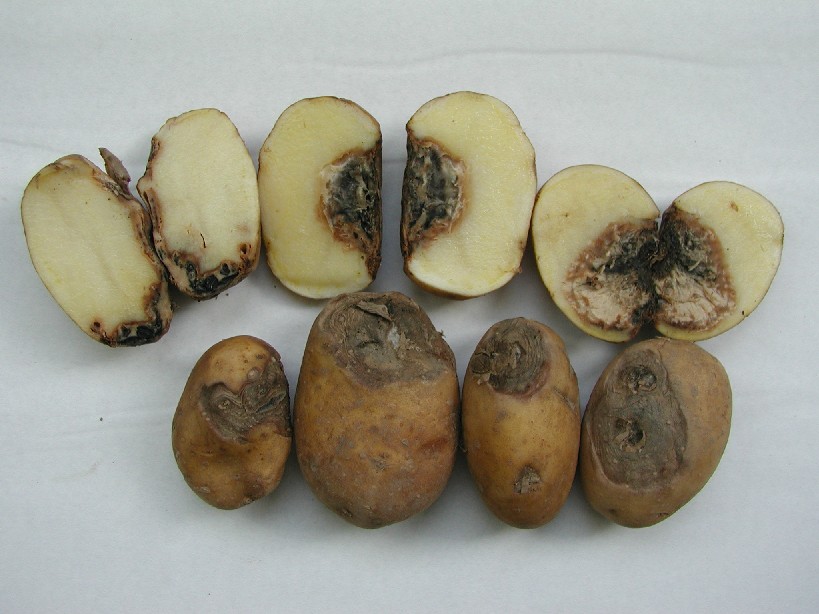 |
|
May be regulated without tolerance in some regions |
|
Leak (watery wound rot) |
Pythiales |
Pythium spp |
Tolerance for wet rot |
Visual observation of tubers and identification on specific medium |
Tuber: rots develop at wounds soon after harvest when growing conditions are hot. Tubers are discoloured with greasy feel. Rots develop in flesh of tuber with a clear dark line separating healthy outer tissue from spongy, soft brown diseased tissue which turns dark on exposure to air. |
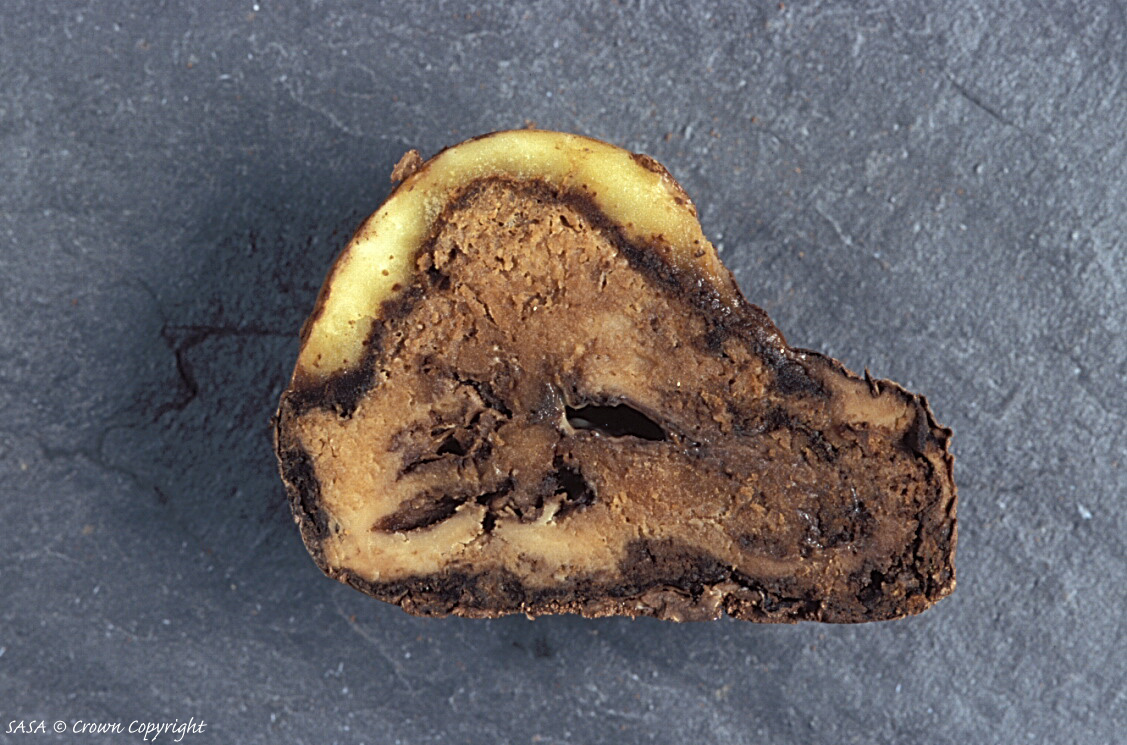 |
|
|
| Pink rot |
|
Phytophthora erythroseptica |
Tolerance for wet rot |
Visual observation of tubers and identification on specific medium |
Tuber: rots develop at lenticels and eyes soon after harvest when conditions have been wet and warm just before harvest. |

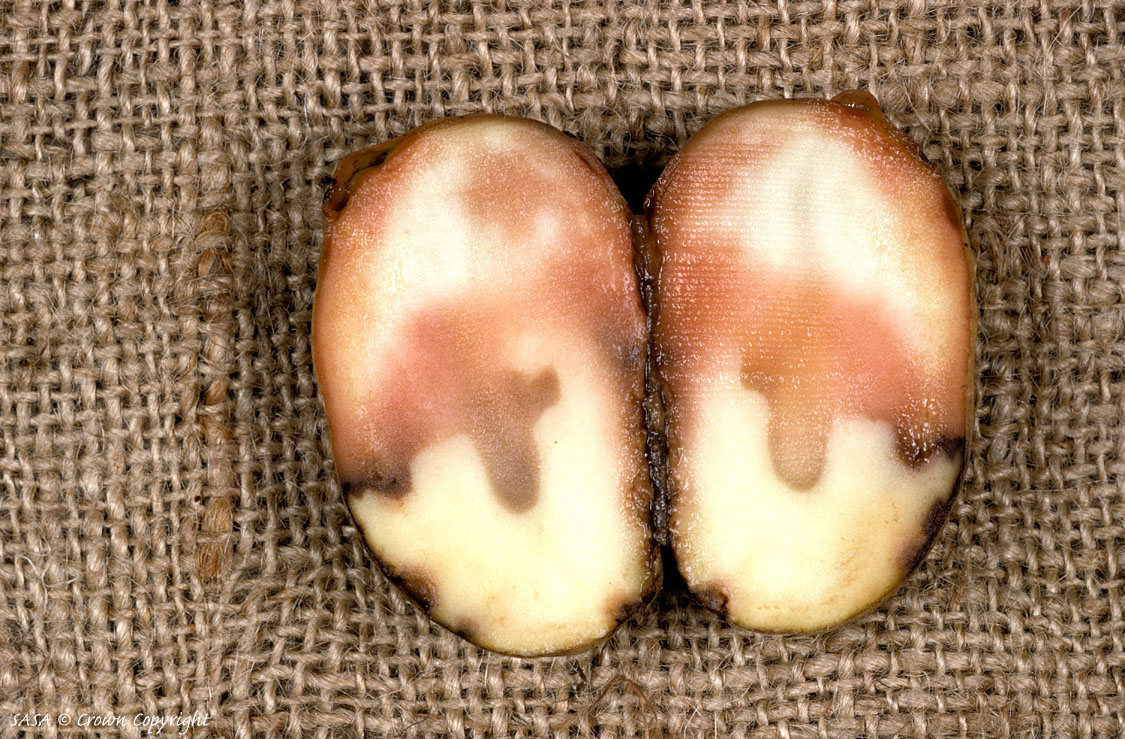
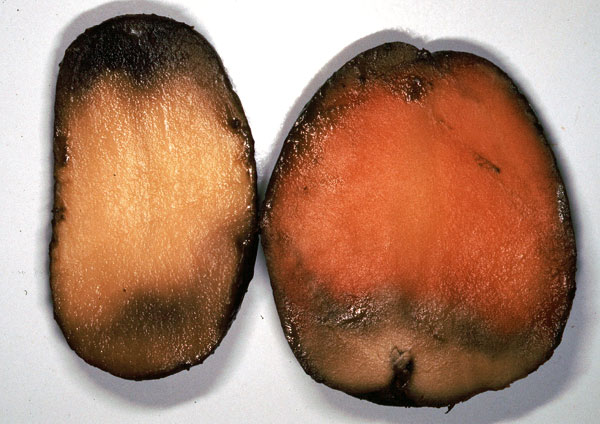 |
|
|
| Rubbery rot |
|
Goetrichum candidum |
Tolerance for wet rot |
Visual observation of tubers and identification on specific medium |
Tuber: rot develops at or soon after harvest in tubers from waterlogged soils. Tuber surface is discoloured with patches of white mycelium developing on surface which feels damp. Internally, a grey, watery rot develops rapidly inwards from skin with a sour milk smell. |
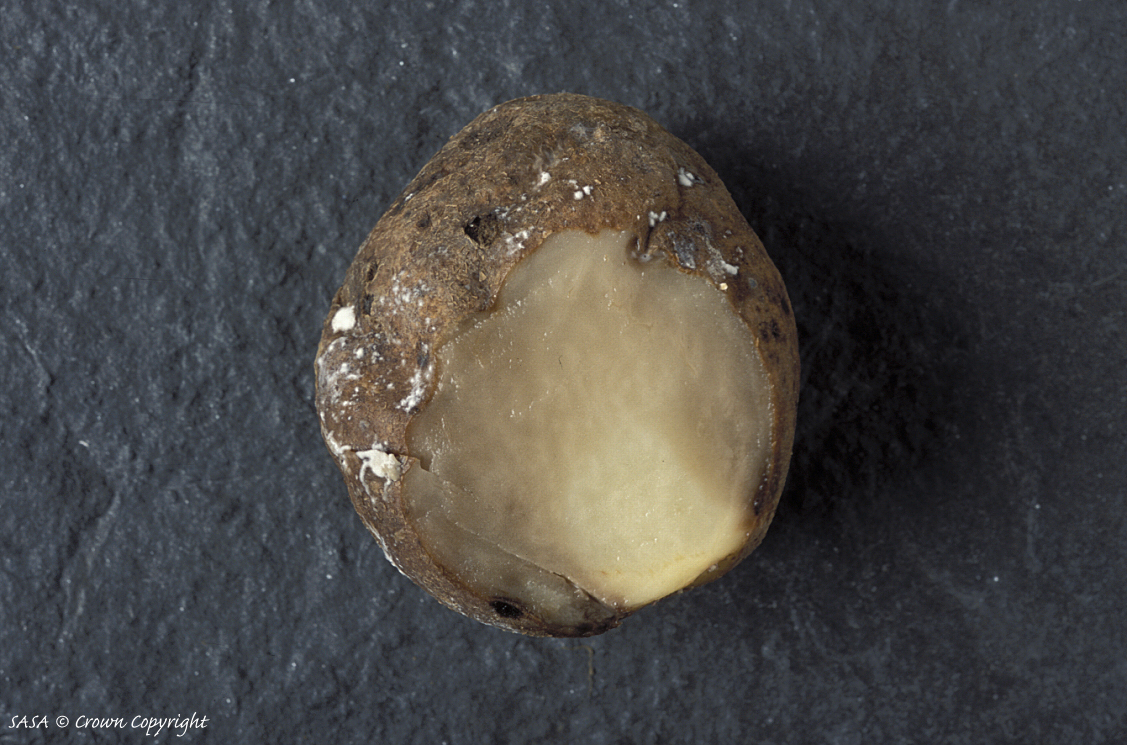 |
|
|
Rhizoctonia Black scurf
(on tuber)/
Stem canker
(on the plant) |
Rhizoctone brun |
Perfect state: Corticium;
imperfect state: Rhizoctonia solani |
Tolerance on tubers (black scurf) |
Visual observation of plants and tubers |
Tuber: blemish caused by dark brown or black sclerotia forming on tuber surface; coverage may be difficult to assess accurately on unwashed dirty tubers.
Plant: uneven emergence, wilting and stunting.
Stem canker: brown slightly sunken, sharp-edged lesions develop on stem bases.
A superficial white powdery collar of fungal growth may be seen on stems just above soil level. |
 |
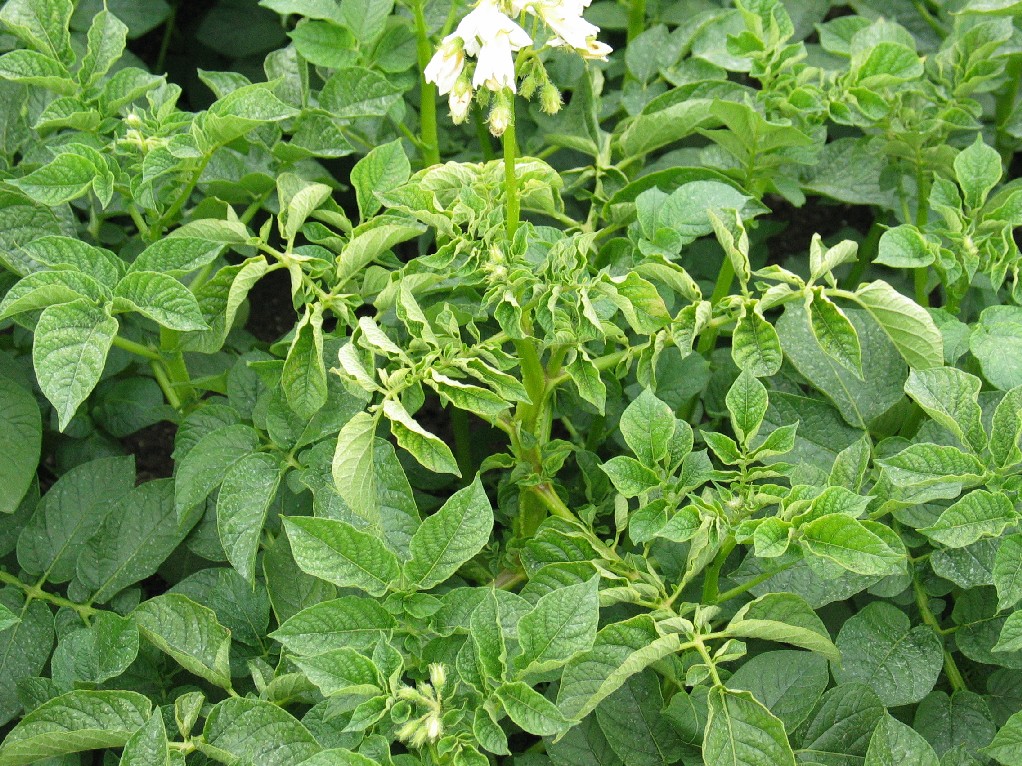
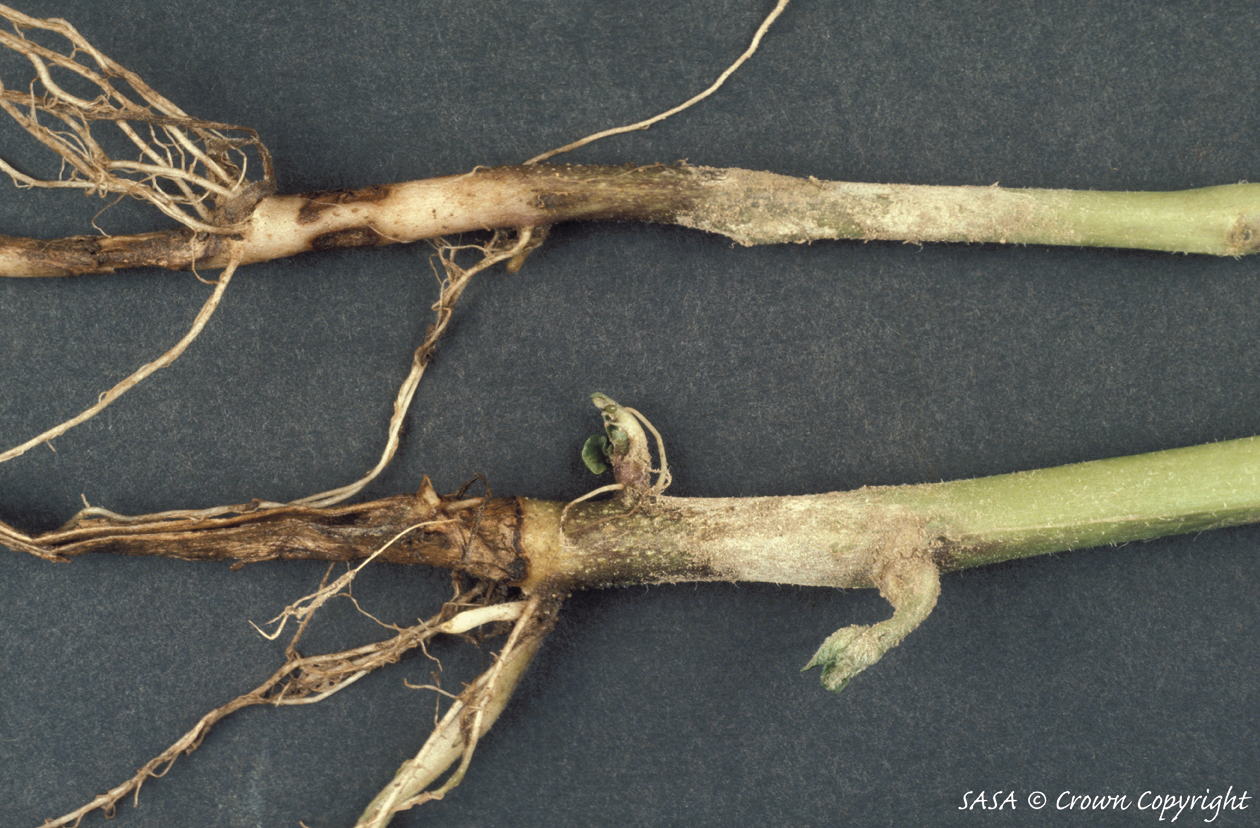 |
Stem canker regulated in some regions. No need for general regulation because regulation of black scurf is seen as more effective |
| Silver scurf |
Gale argentée |
Helminthosporium solani |
Controlled indirectly through tolerance for shrivelled tubers |
Visual observation of tubers and identification on specific medium |
Tuber: skin blemish. Disease starts as small, round, silvery patches on skin. In humid conditions, dark sooty conidiophores can develop around the edge of lesions. Large silvery patches develop as individual lesions expand and merge during storage. |
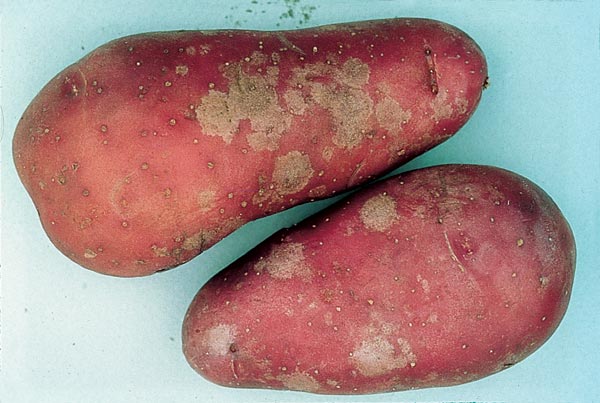
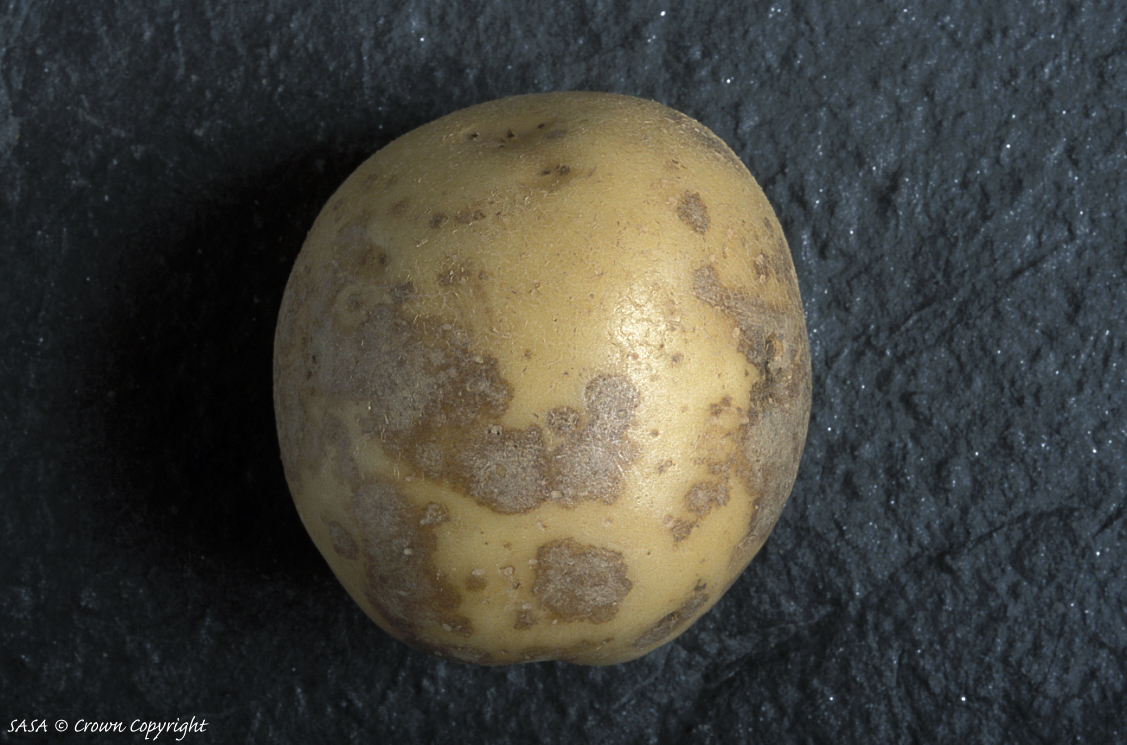
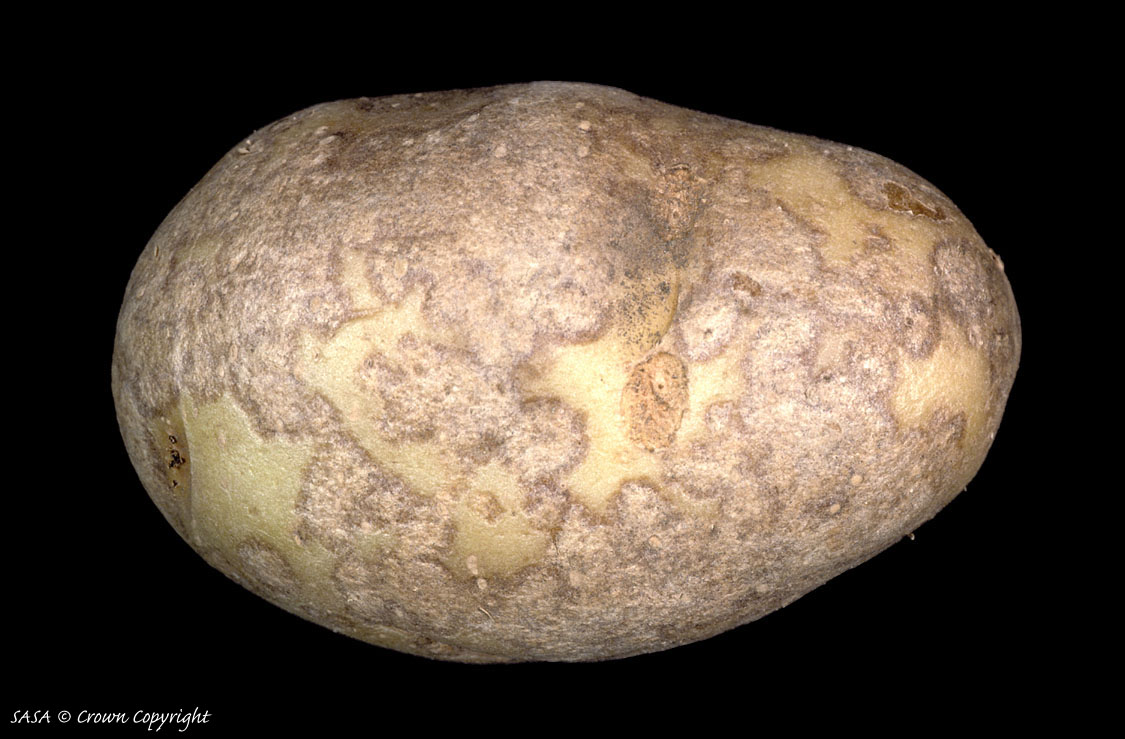 |
|
Regulated with tolerance in some regions |
| Black dot |
Dartrose |
Colletotrichum coccodes |
Controlled indirectly through tolerance for shrivelled tubers |
Visual observation of tubers and identification on specific medium |
Tuber: skin blemish. Silvery, irregularly shaped lesions present at harvest quickly darken. Lesion is less well defined than silver scurf. Oval, pinhead black bodies (microsclerotia) are often visible on the skin.
Growing plant: may contribute to early dying disease in warm climates |
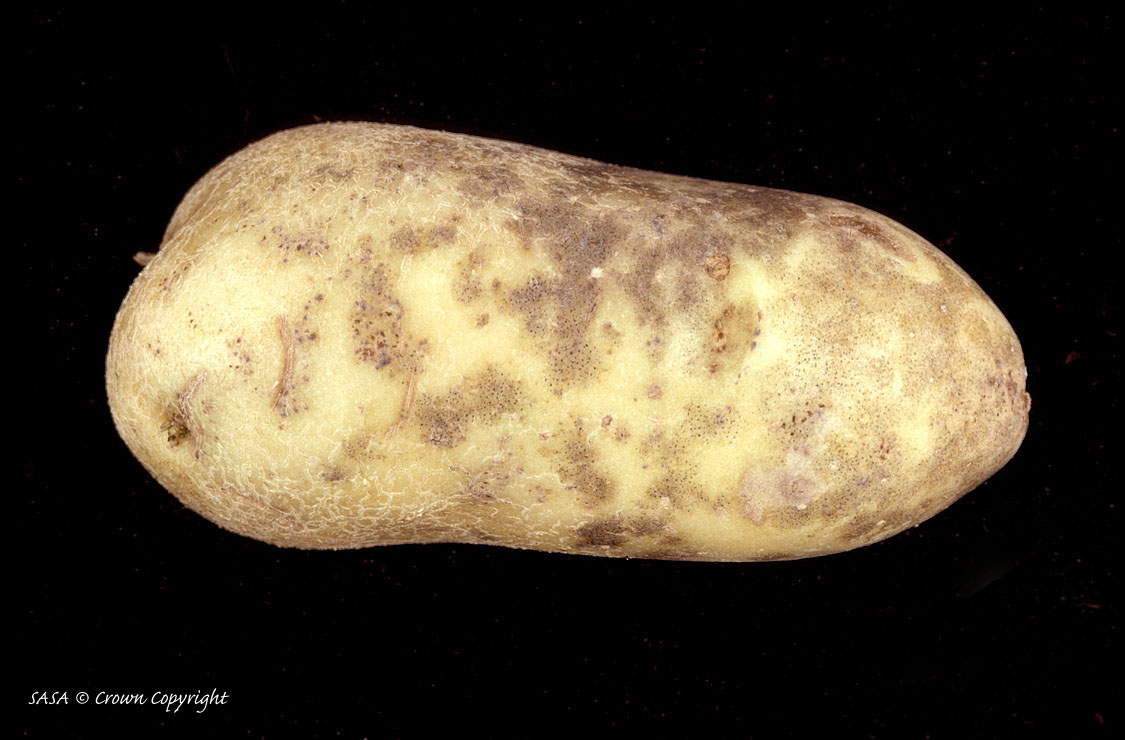 |
|
Regulated with tolerance in some regions |
| Skin spot |
Oosporiose |
Polyscytalum pustulans |
Not regulated |
Visual observation of tubers |
Tuber: skin blemish and death of eyes. Small (1-2 mm),
brown-black pimples develop on the skin, usually 2-3 months after harvest, eyes may be killed.
Plant: uneven and non-emergence |
 |
|
Regulated with tolerances in some regions. No need for a general regulation, not a barrier to trade. |
| Early blight |
Alternariose |
Alternaria solani and Alternaria alternata |
Controlled indirectly through tolerances for dry rot |
Visual observation of leaves and tubers |
Tuber: largely superficial rot
Plant: necrosis of leaves |
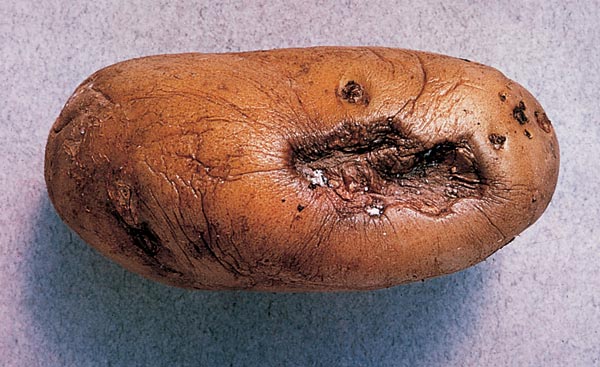 |
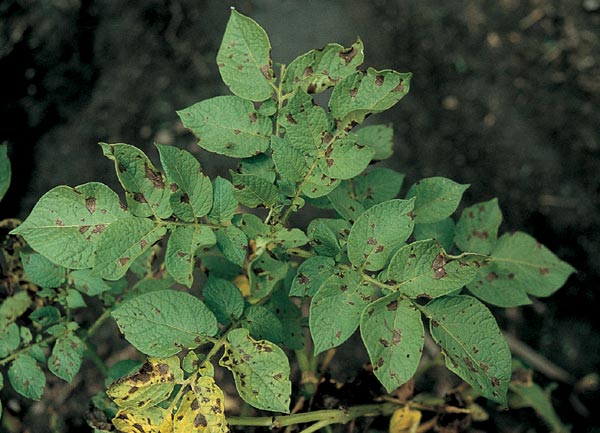 |
|
| White mould |
Sclerotiniose |
Sclerotinia sclerotiorum |
Controlled through tolerance for dry rot |
Visual observation of stem |
Tuber: rot at heel end, rare. Internal rot is pale brown with fluffy white
mycelia and black sclerotia developing in cavities.
Plant: wilting and death of individual stems.
Pale green to white, water-soaked lesions develop at base of stem, reddish brown zones develop on
these lesions accompanied by growth of woolly, white mycelia in humid conditions. |
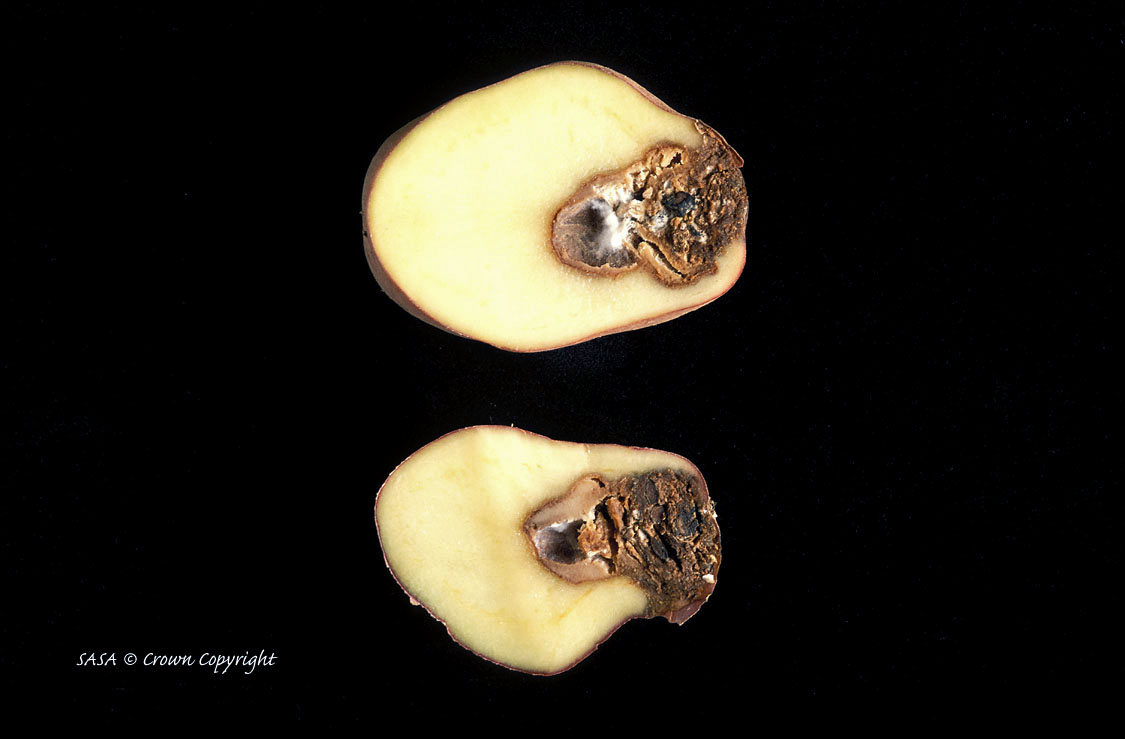 |
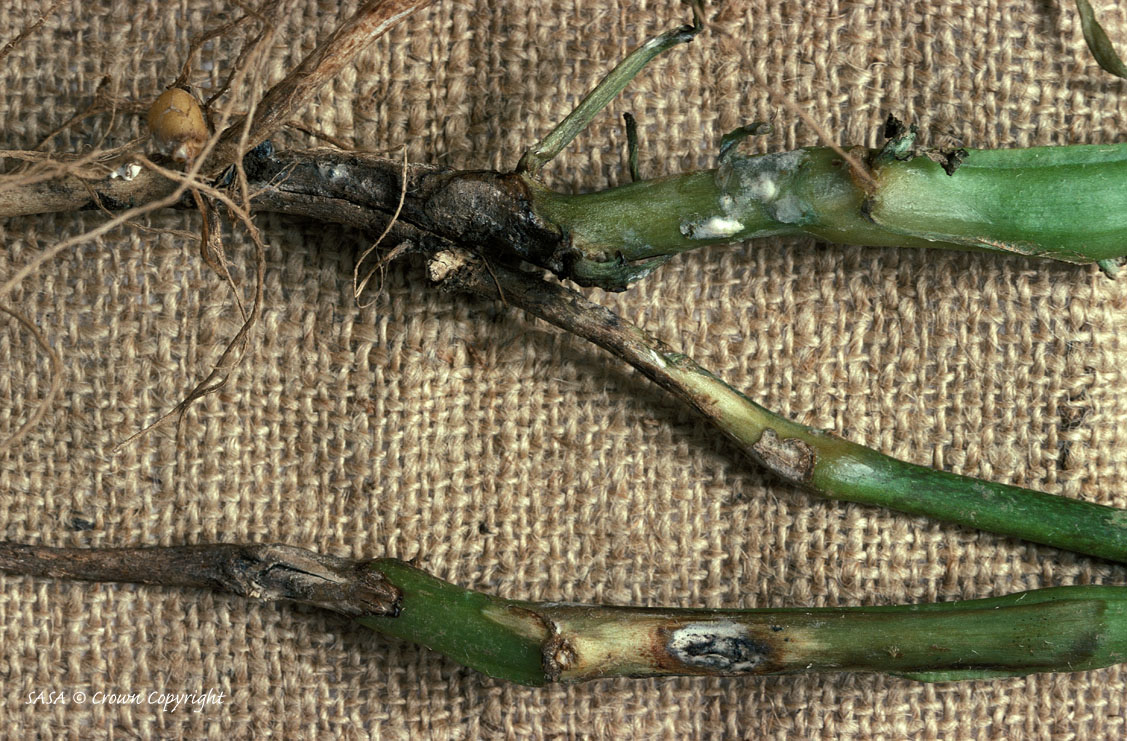
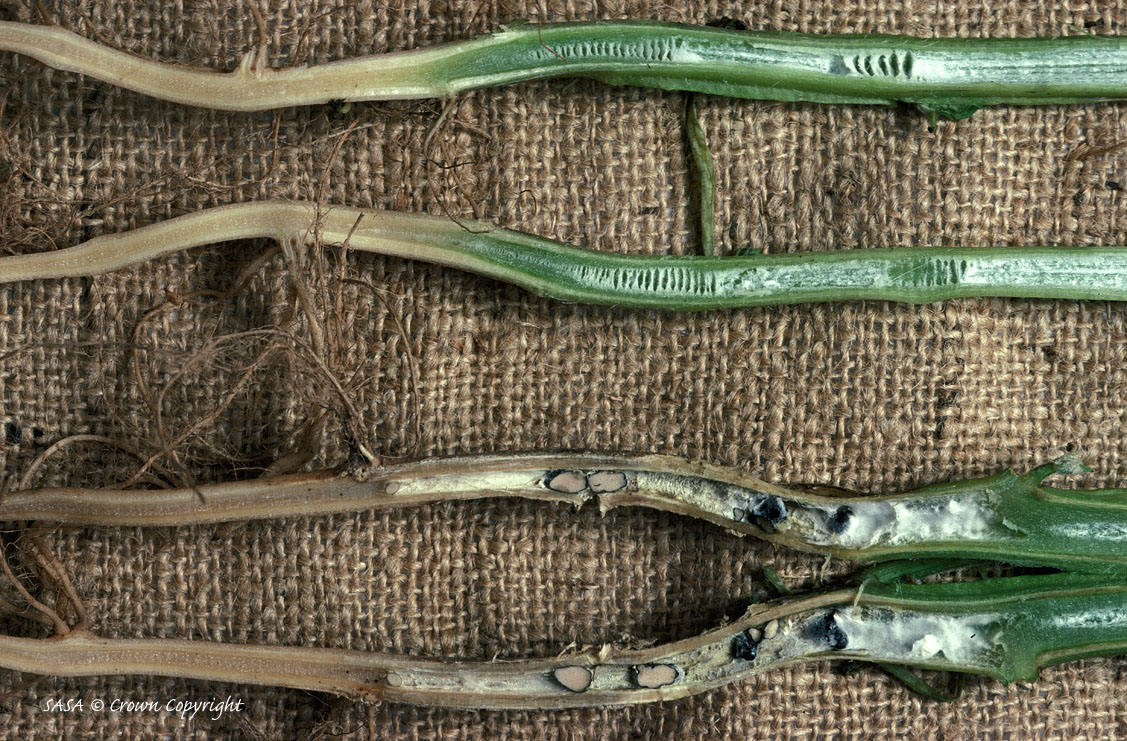
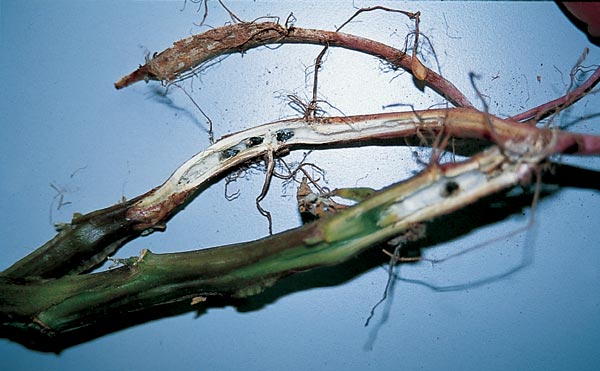 |
Not to be regulated. Infection is from soil inoculum and not from the tuber |
| Powdery scab |
Gale poudreuse |
Spongospora subterranea |
Tolerance |
Visual observation of tubers with confirmation by microscope |
Tuber: round individual raised scabs present on tubers at harvest,
lesions erupt exposing brown powdery tissue (sporeballs) leaving tattered fragments of skin along
edge of lesion. Infection at time of eye development can result in outgrowths (cankers) of varying
sizes developing at rose end of tubers.
Powdery scab spore balls at 250 times magnification. |
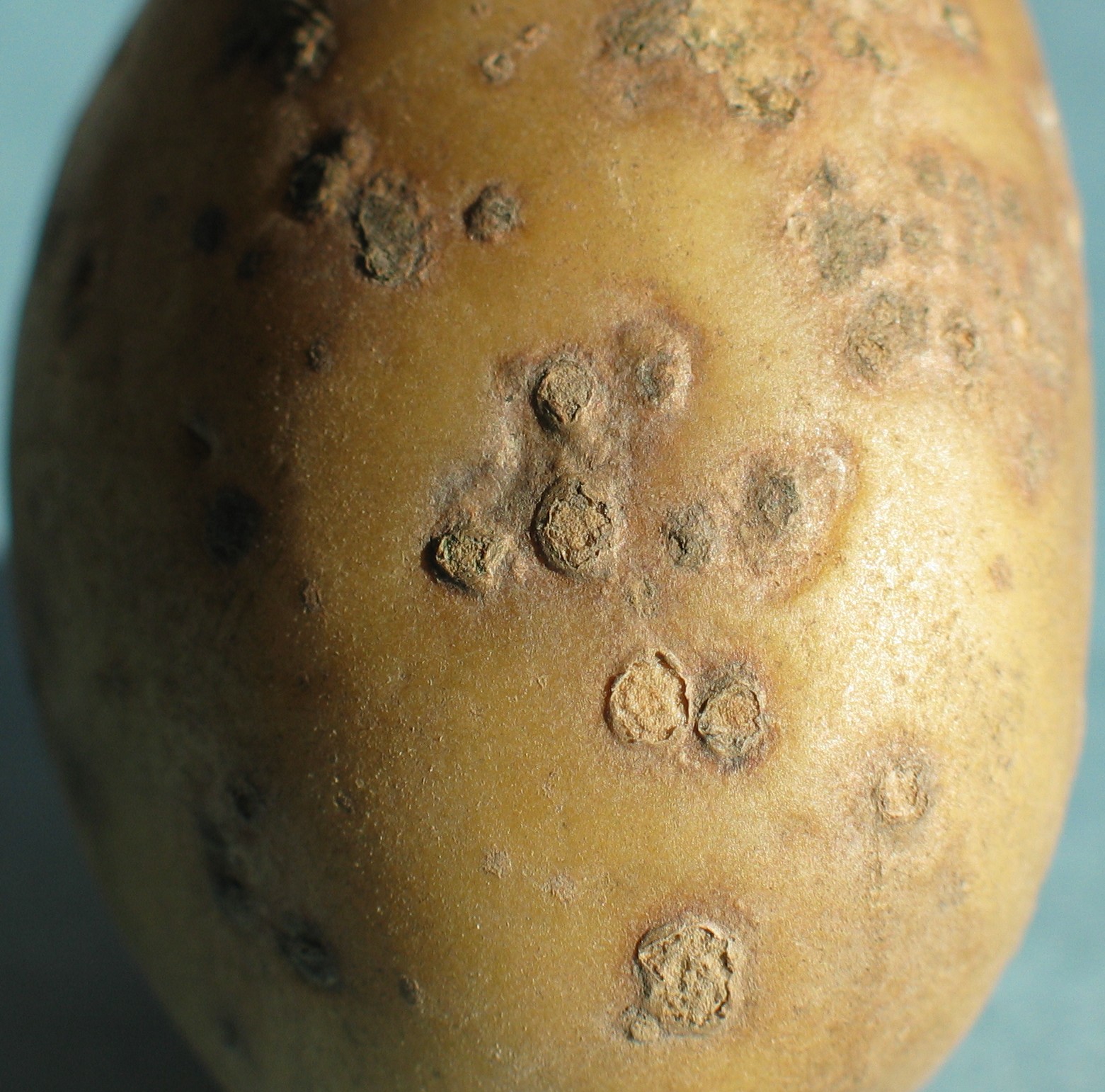
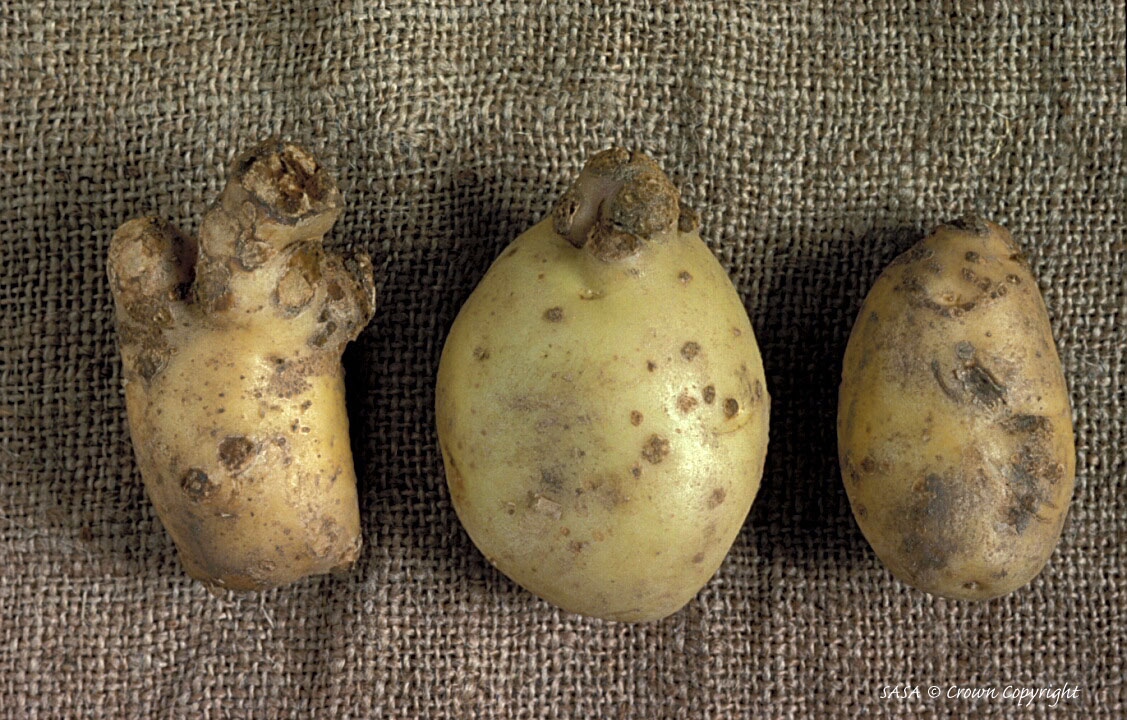
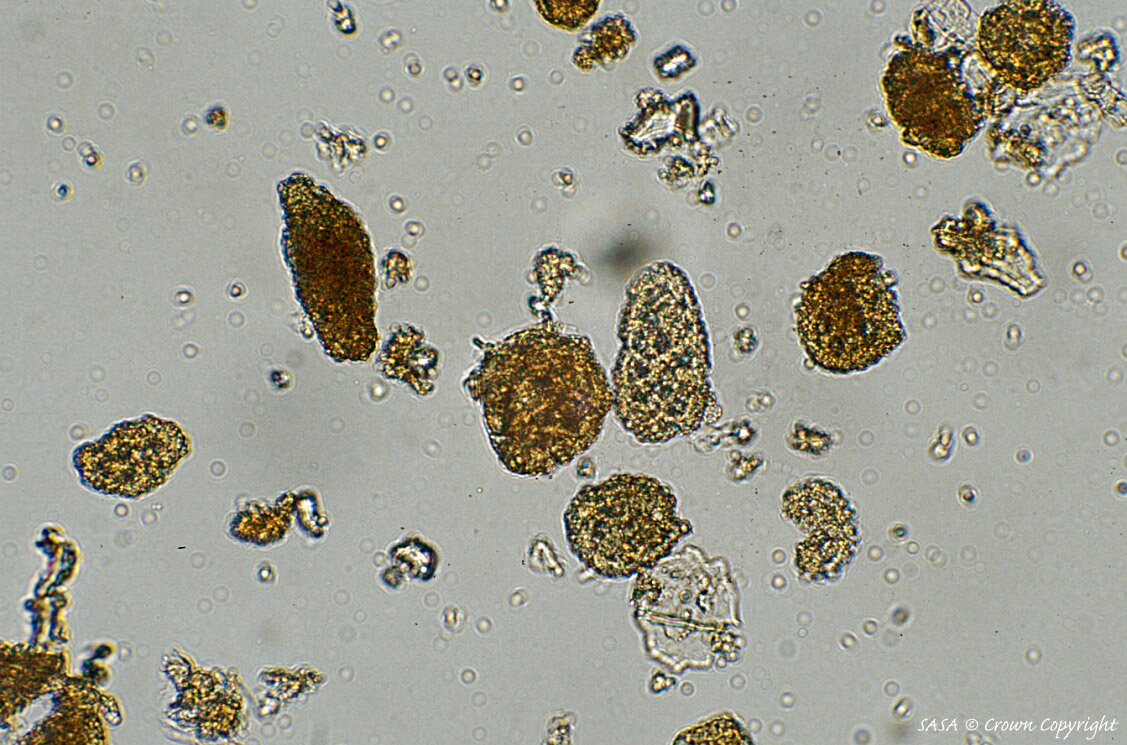 |
|
May be regulated with tolerance in some regions |
| Verticillium wilt |
Verticilliose |
Verticillium dalhiae and V. alboatrum |
Not regulated |
Visual observation of leaves and plant |
Tuber: vascular discolouration
Plant: wilting and death |
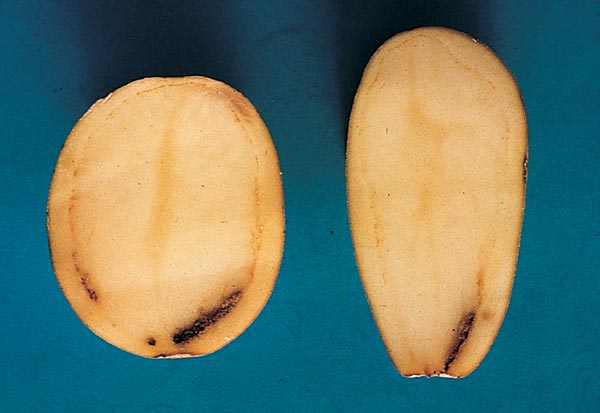 |
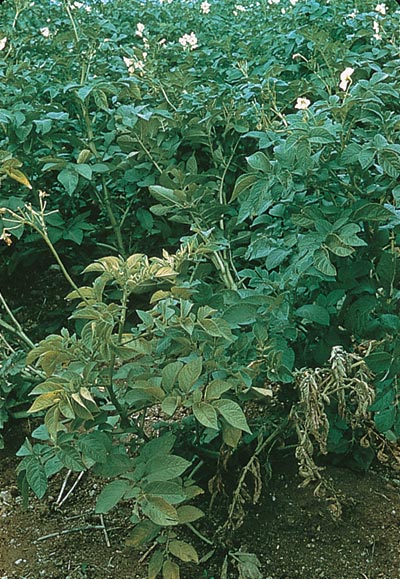 |
No need for regulation in UNECE standard because path of infection is primarily though infested soil and not the seed tuber. |
| |
|
|
|
|
|
|
|
|
| VIRUS |
| |
|
|
|
|
|
|
|
|
| Severe mosaic |
Virose grave |
Potato viruses Y (all strains), A, V and M, and in combination with PVX and S |
Tolerance for severe virus |
Visual observation of plant and ELISA test |
Plant: distortion or deformation of leaves or plants. This can be rugosity, crinkle, rolling and rigidity of the leaves. Mottling of leaflets may also occur.
Tuber: superficial necrosis caused only by PVY strains |
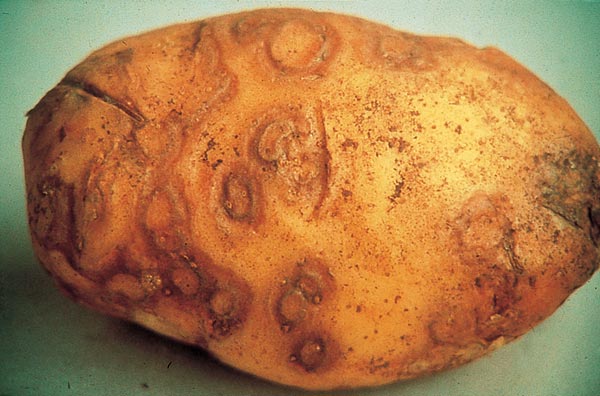 |
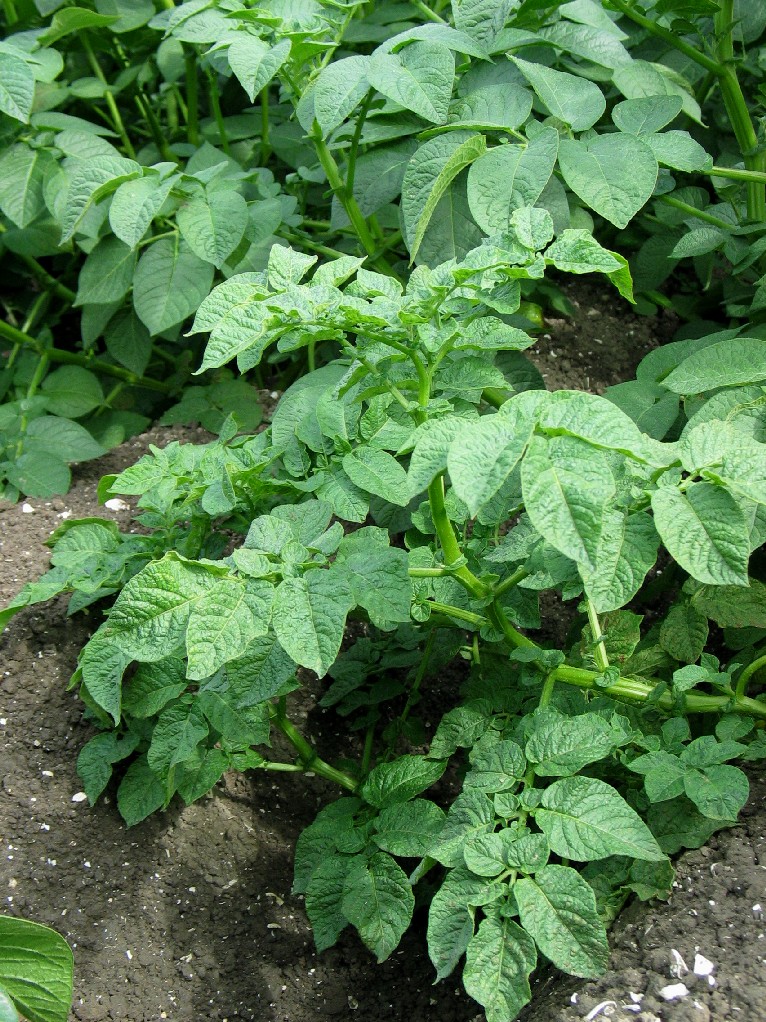
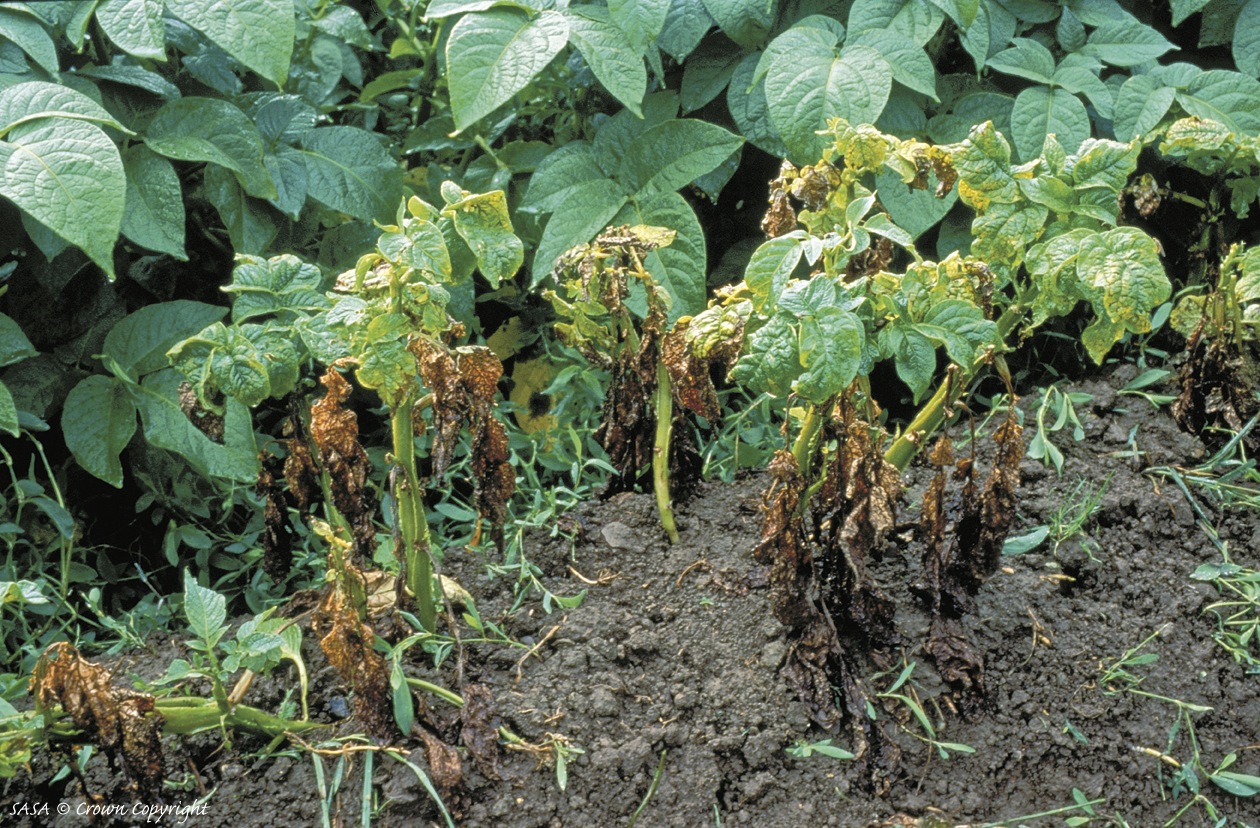
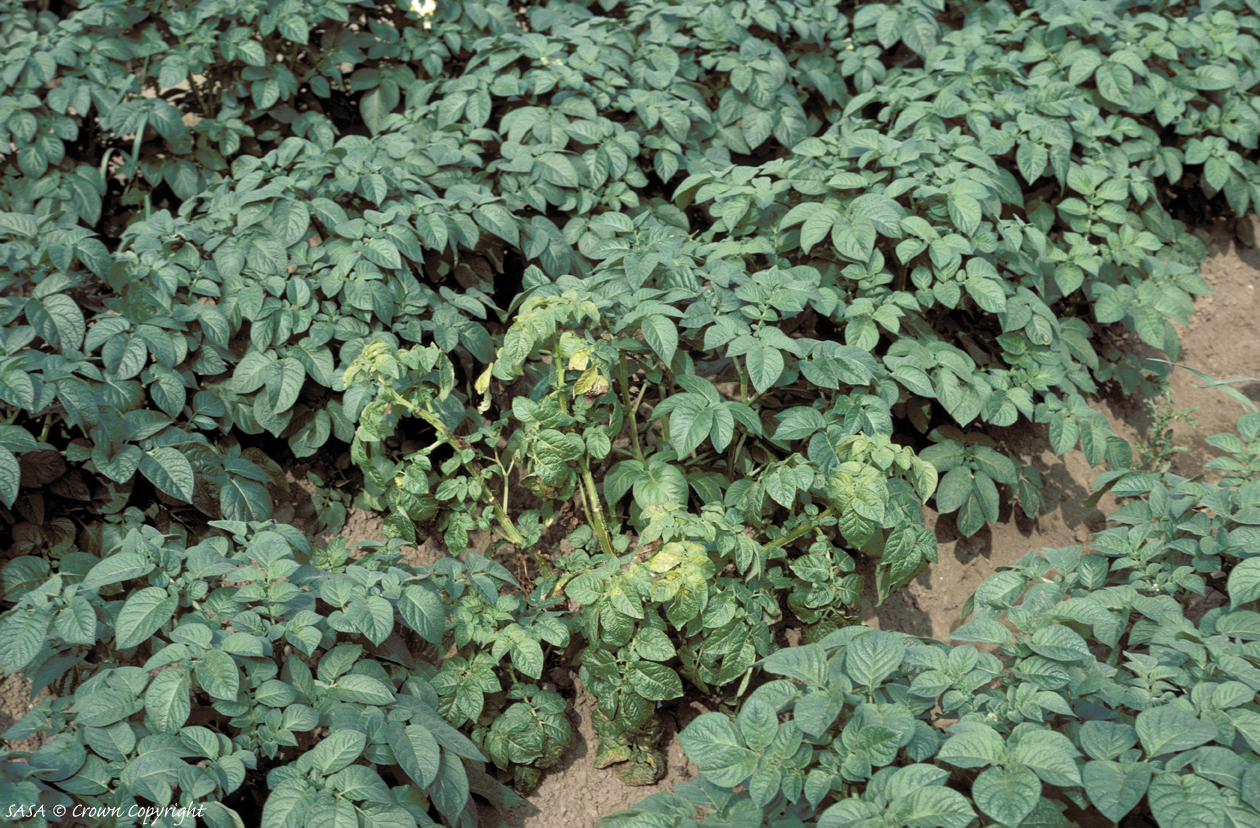
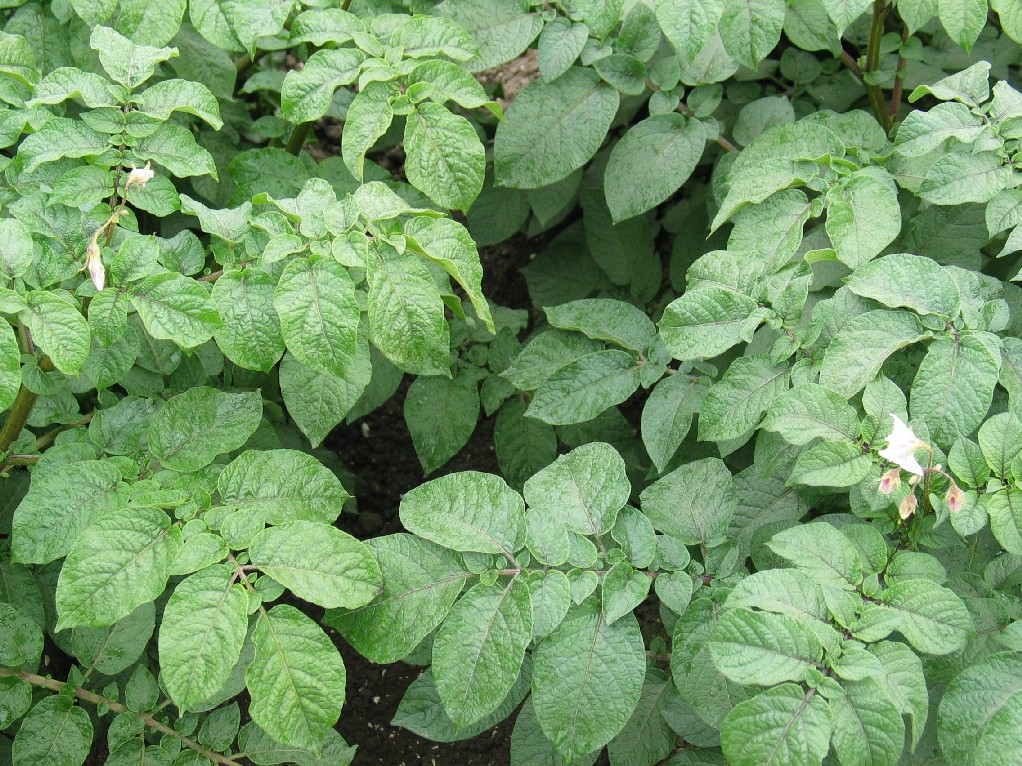
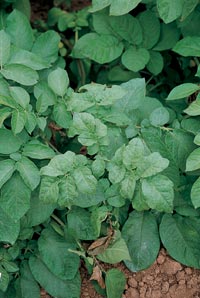 |
Tuber symptoms, regulated with tolerance in some regions |
| Mild mosaic |
Virose légère |
PVX, PVS and PVY strains, especially PVYN |
Tolerance for mild mosaic |
Visual observation of plant and ELISA test |
Plant: discolouration or mottle of leaves without distortion
Tuber: superficial necrosis caused only by PVY strains |
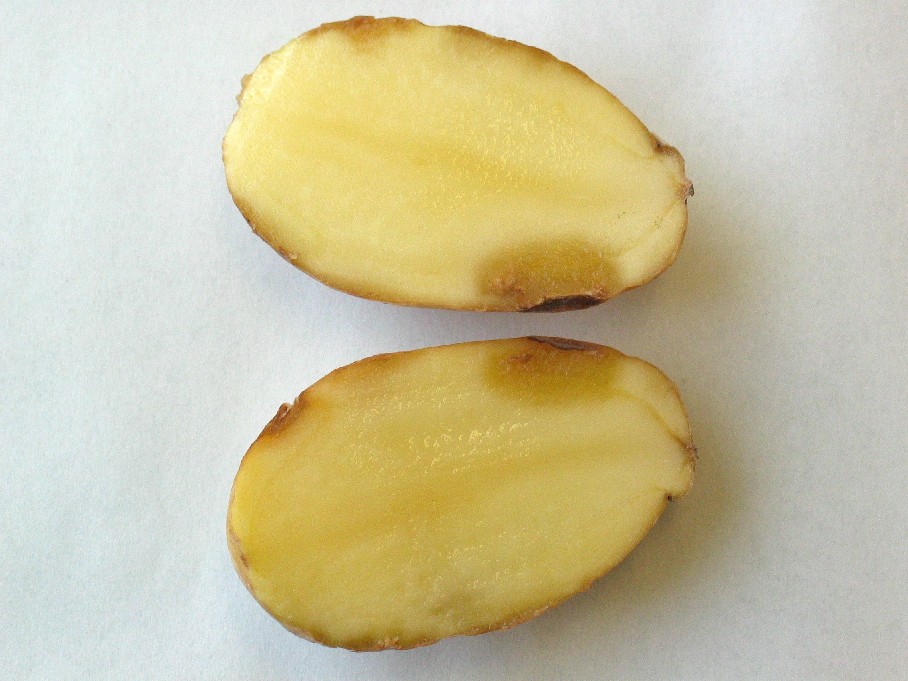 |
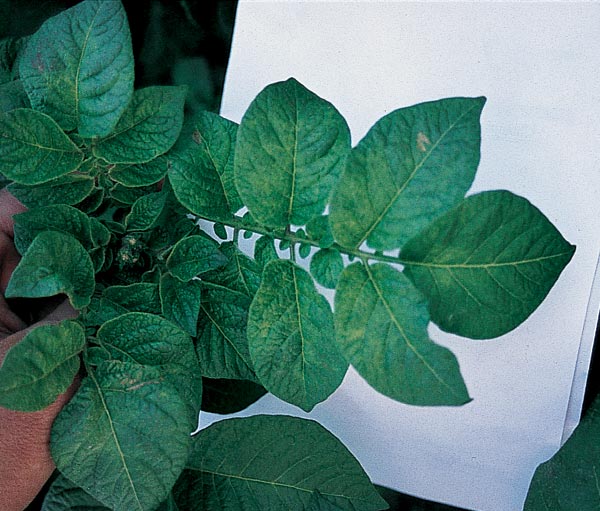
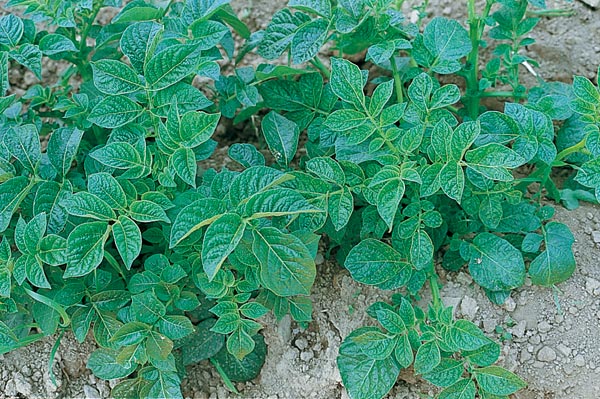
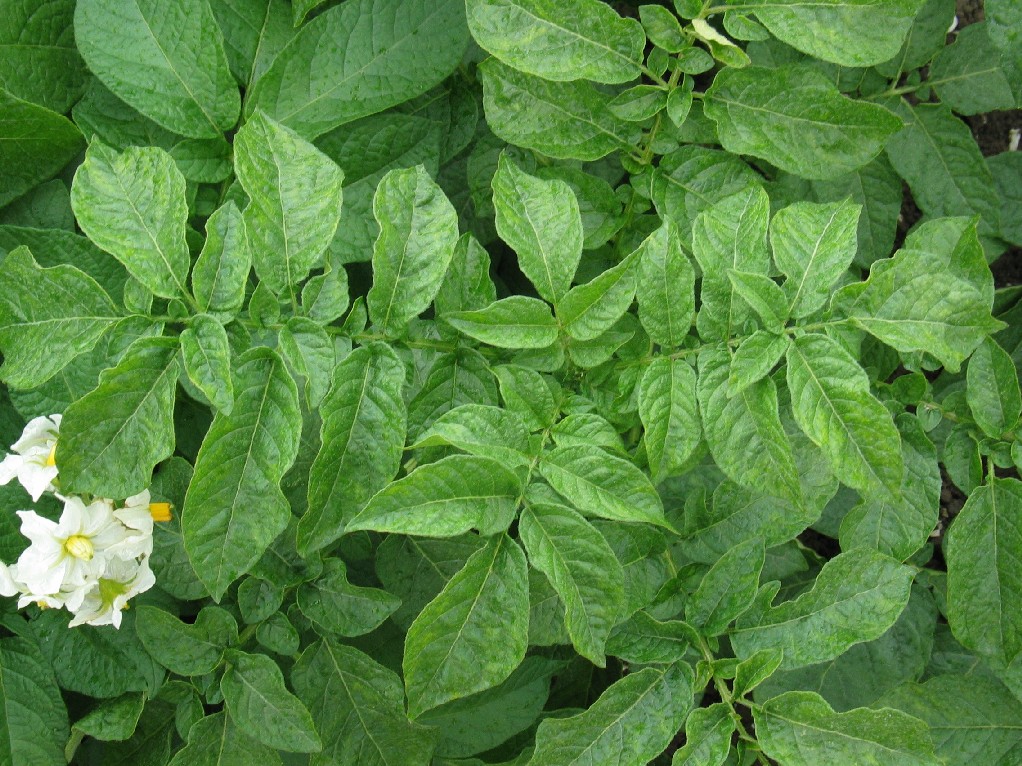
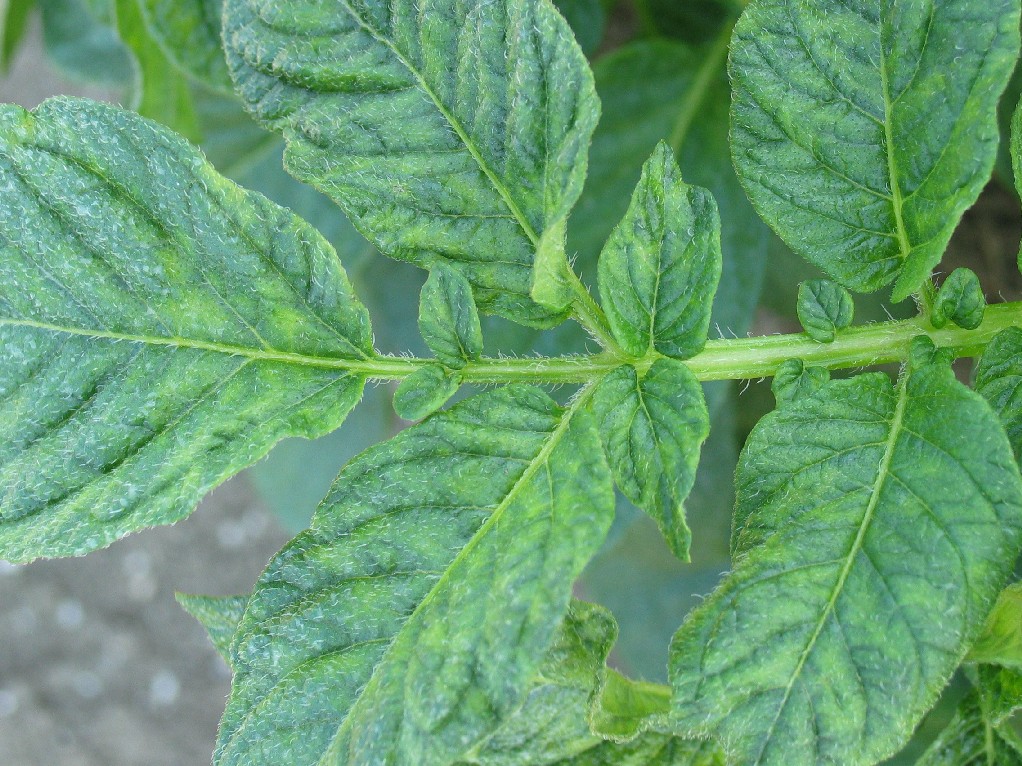
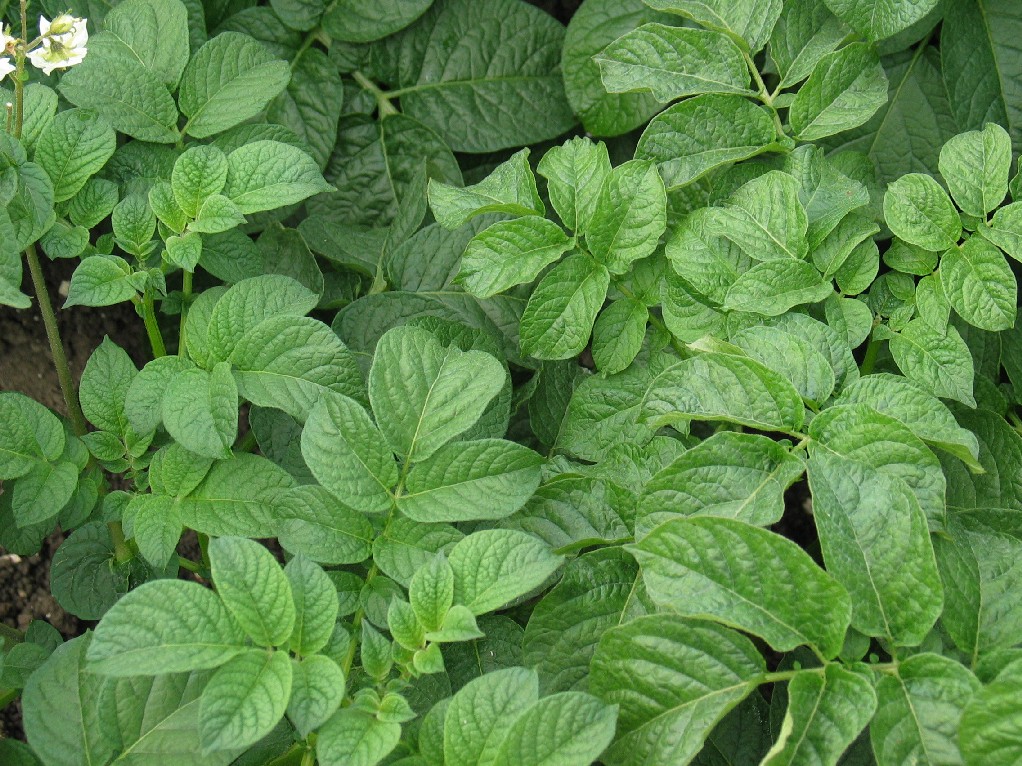 |
Tuber symptoms, regulated with tolerance in some regions |
| Leafroll |
Enroulement (Virus E) |
Potato leafroll virus (PLRV) |
Tolerance for severe virus |
Visual observation of plant and ELISA test |
Plant: rolling of leaves and stunting
Tuber: net necrosis in flesh |
|
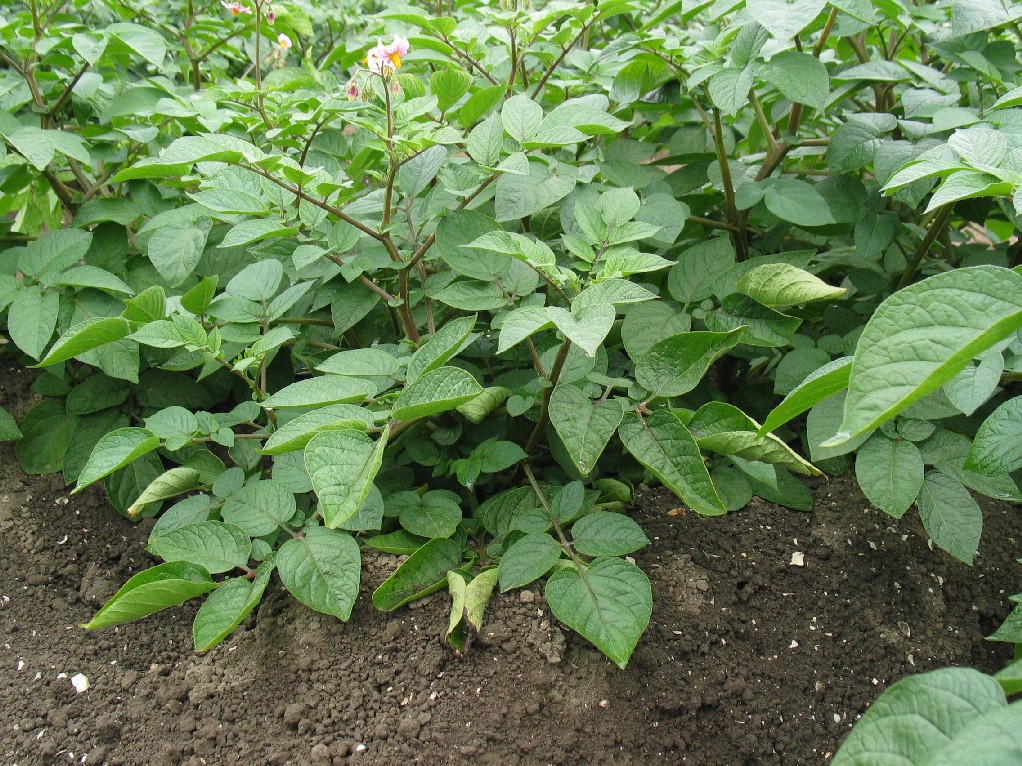
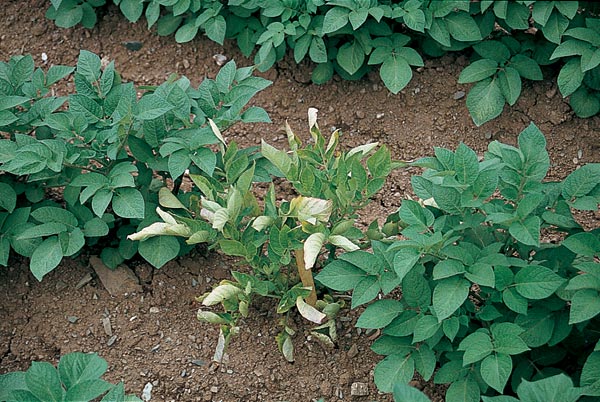 |
|
Mop top
(Spraing in tubers) |
Mop top |
Potato mop-top virus (PMTV) |
Not regulated1 |
Visual observation of plant and tubers, ELISA test and PCR |
Plant: marked mottling of leaves and stunting of all or some stems. Yellow chevrons and blotching on leaves and stunting of all or some stems.
Tuber: necrotic rings or arcs on surface and in flesh |
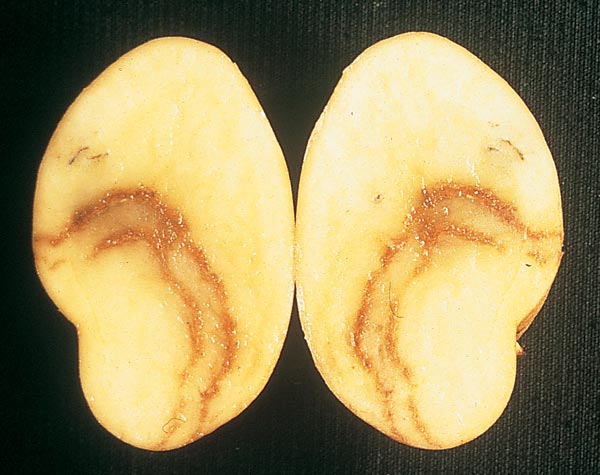
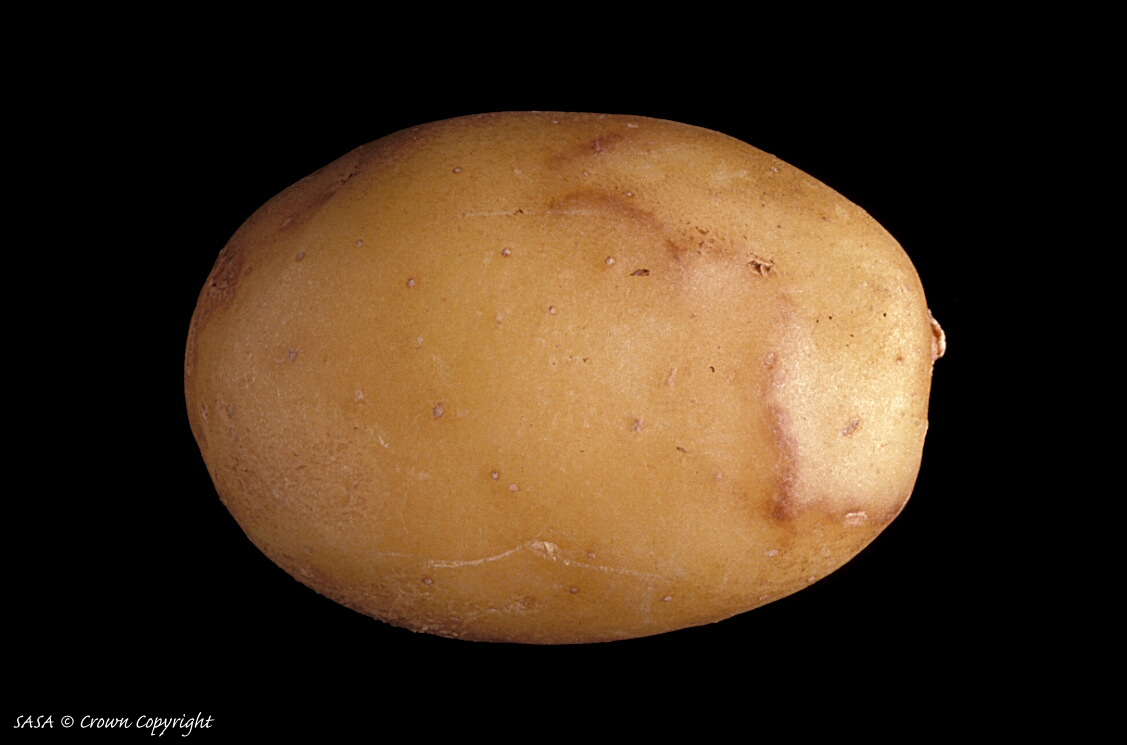 |
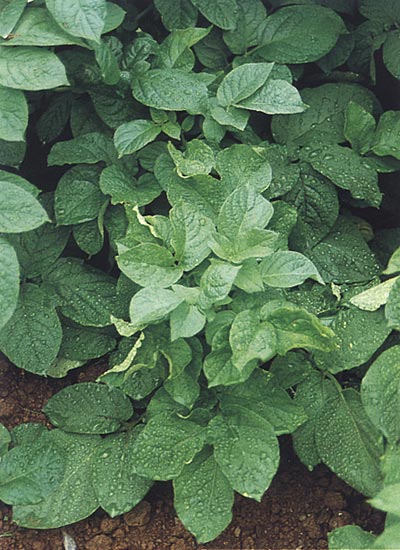
 |
Regulated with a zero tolerance in some regions |
| Tobacco rattle virus (Spraing in tubers) |
Rattle |
Tobacco rattle virus |
Not regulated1 |
Observation of tubers and PCR |
Plant: mottling and distortion of leaves and stunting of some or all stems
Tuber: brown, corky arcs and spots in the tuber flesh which are sometimes visible on the skin surface |
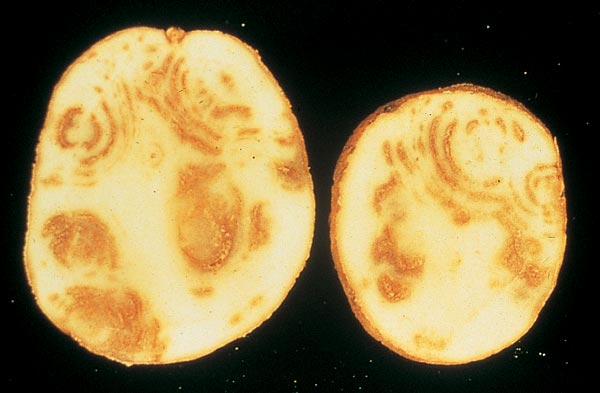
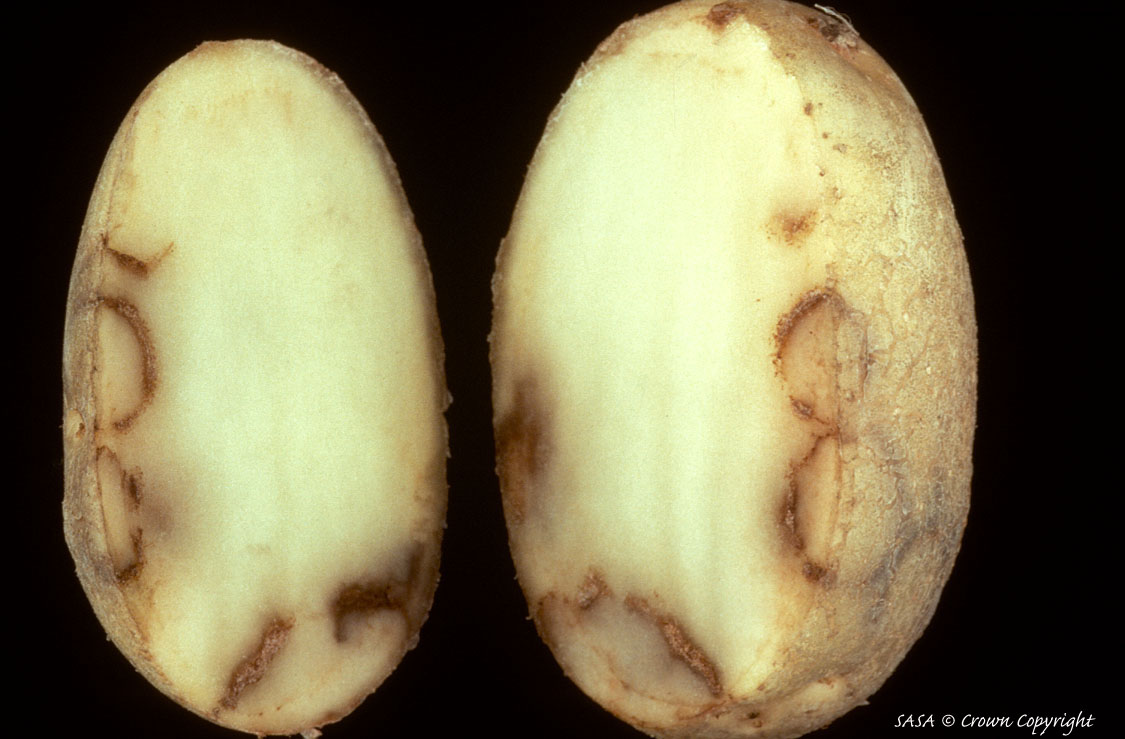 |
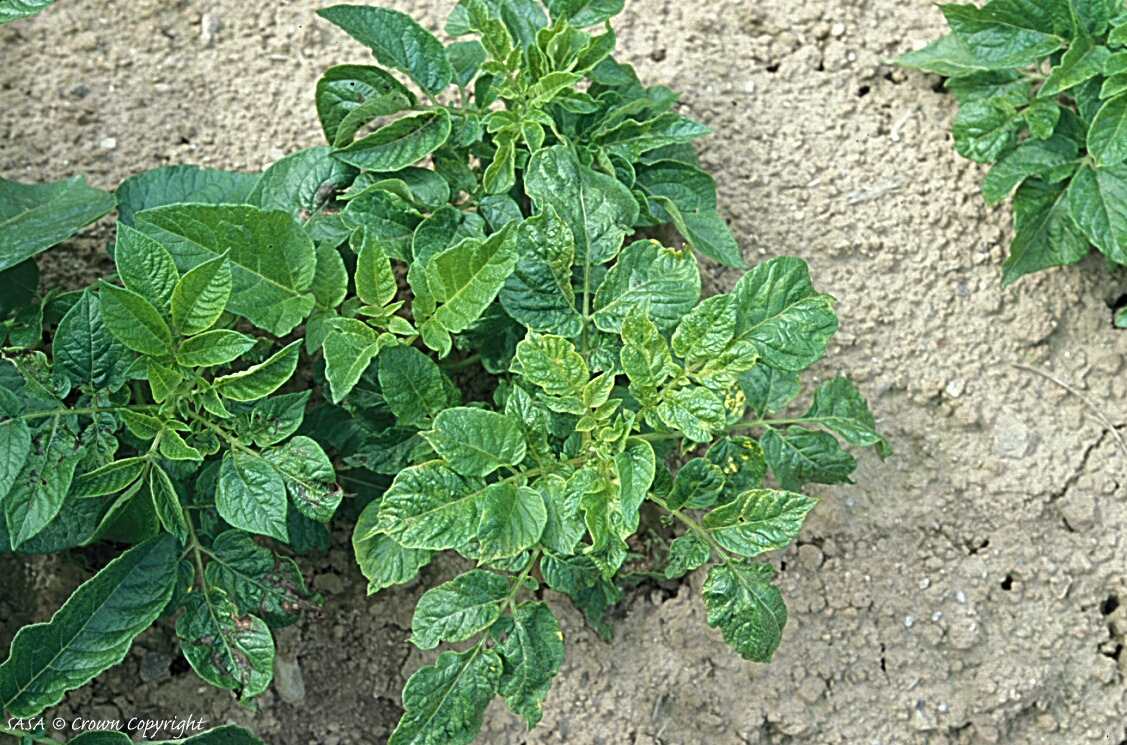 |
Regulated in some regions with tolerance |
| Tomato spotted wilt virus |
TSWV |
Tomato spotted wilt virus |
Not regulated |
|
Plant: leaf spotting and necrosis
Tuber: skin blemish and internal necrotic spotting |
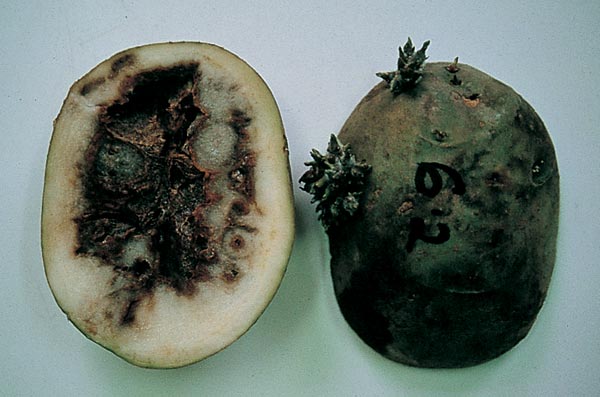 |
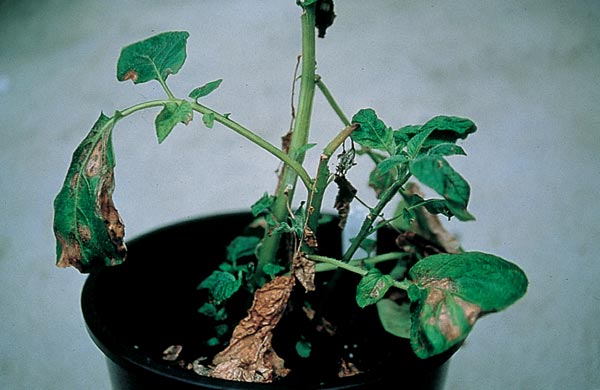 |
Regulated in some regions
with zero tolerance |
| |
|
|
|
|
|
|
|
|
| BACTERIA |
| |
|
|
|
|
|
|
|
|
| Blackleg |
Jambe noire |
Pectobacterium atrosepticum (syn. Erwinia carotovora subsp. atroseptica) and Pectobacterium carotovorum (syn. E. carotovora subsp. carotovora), Dickeya spp. (syn. E. chrysanthemi) |
Tolerance for crop and tuber for wet rot |
Observation of plant and tuber |
Plant: yellow, rolled upper leaves on blackleg plant; black slimy rots developing on stems.
Tuber: watery, soft rot of disintegrating flesh and pungent smell |
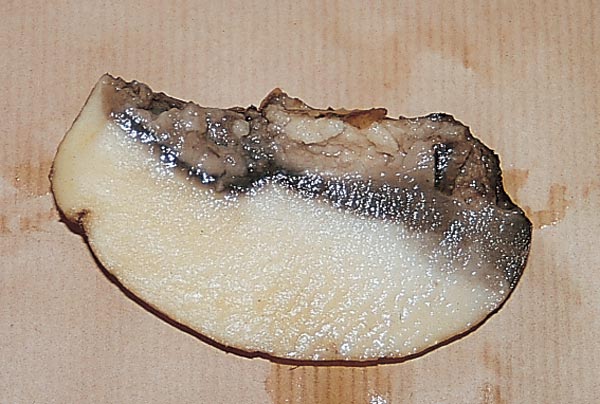
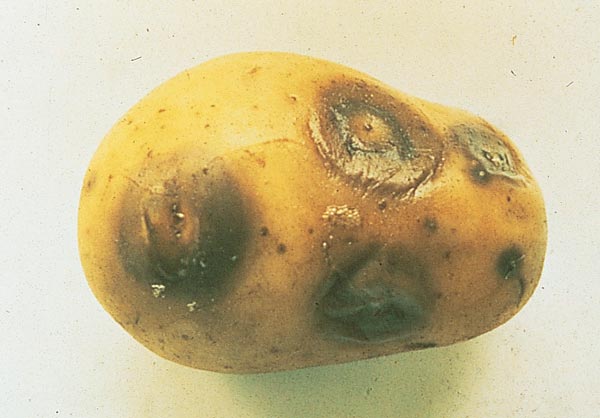
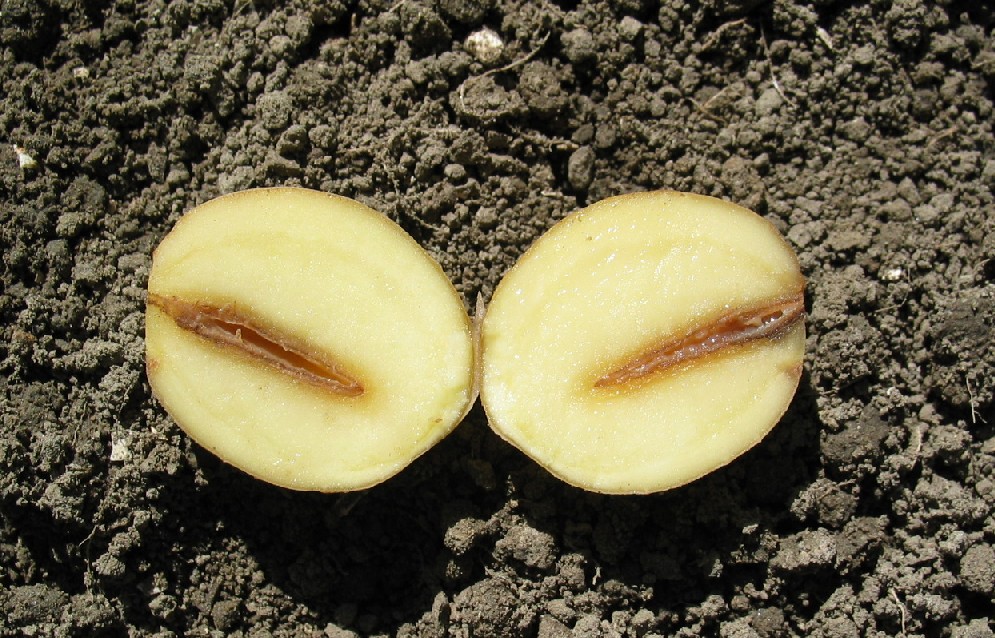 |
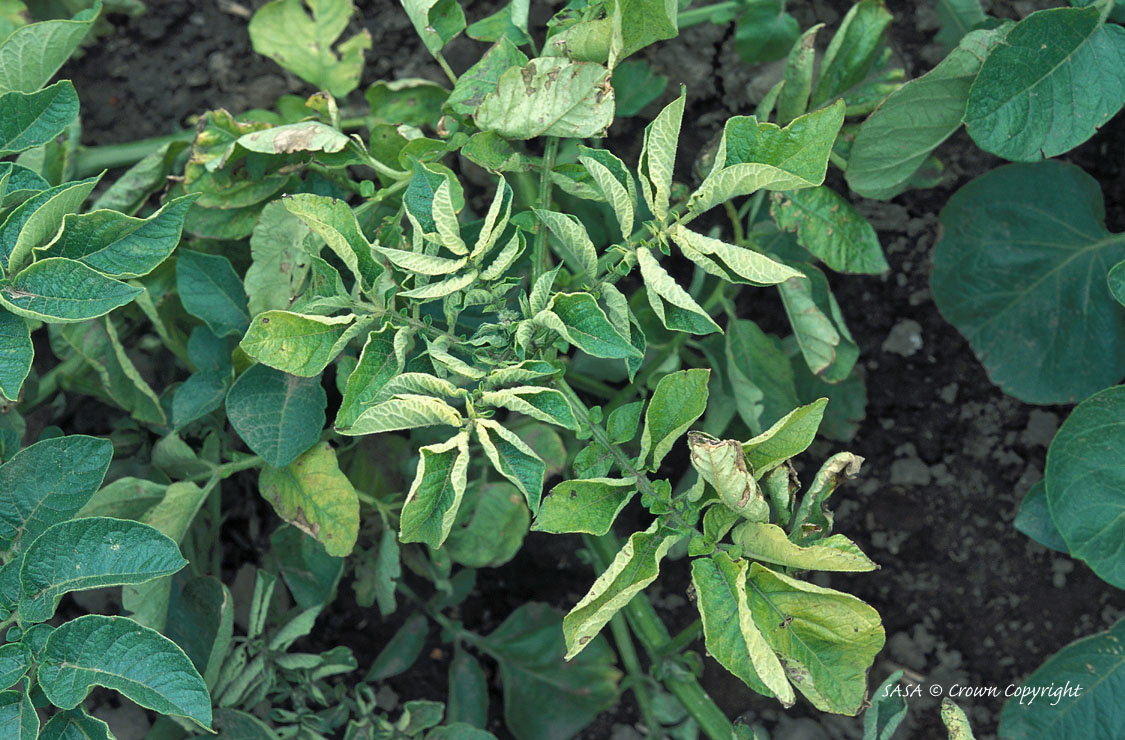
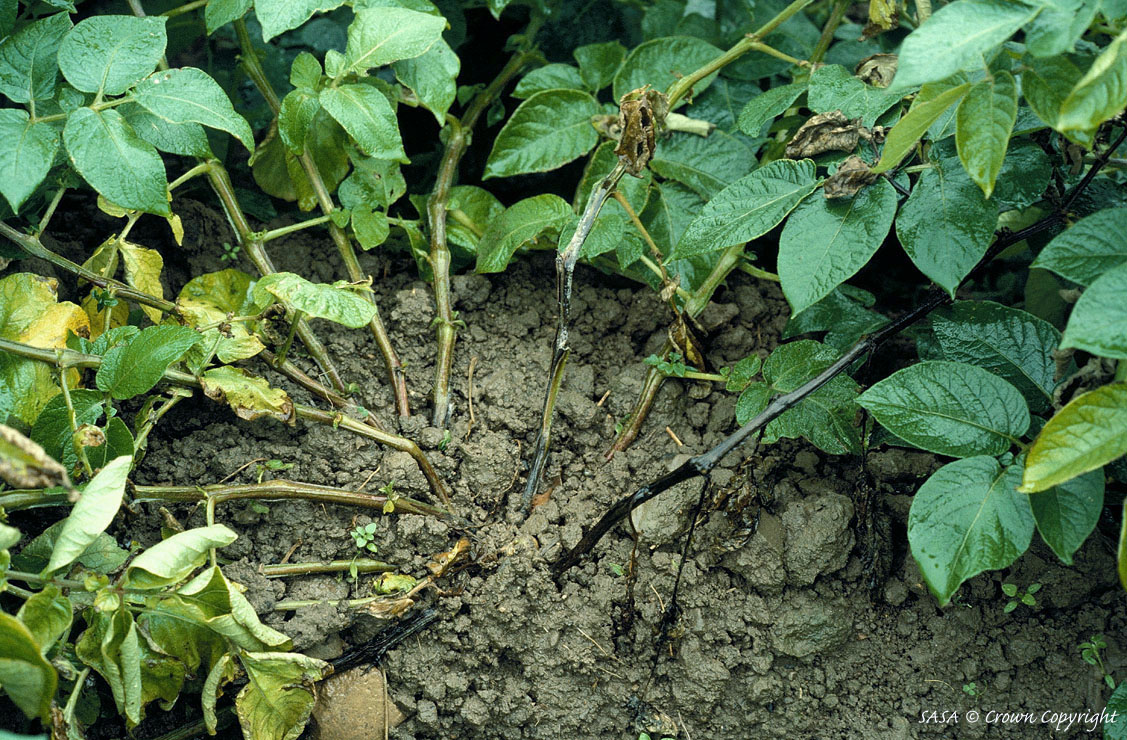 |
|
| Ring rot |
Flétrissement bactérien, pourriture annulaire |
Clavibacter michiganensis subsp. sepedonicus |
Zero tolerance |
Observation of plant and tuber, test by IF and PCR |
Tuber: vascular soft rot
Plant: wilting and death |
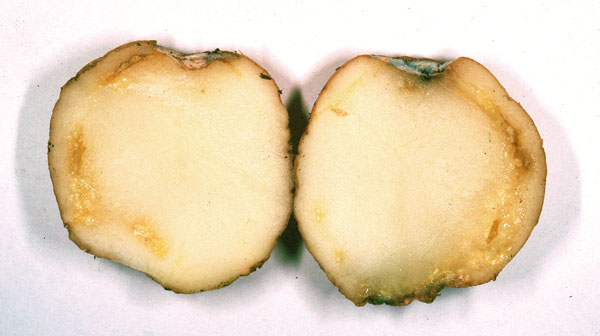 |
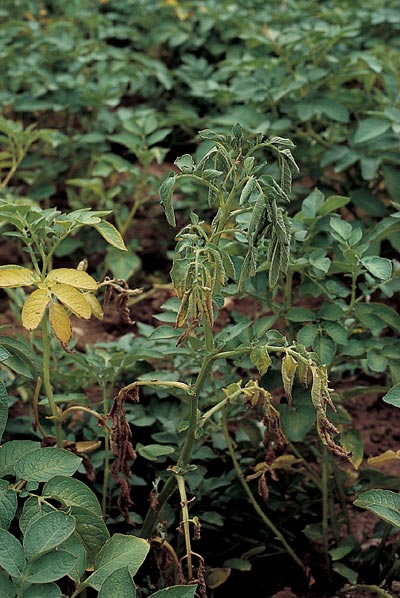 |
|
| Brown rot |
Pourriture brune |
Ralstonia solanacearum |
Zero tolerance |
Observation of plant and tuber, test by IF and PCR |
Tuber: vascular soft rot
Plant: wilting |
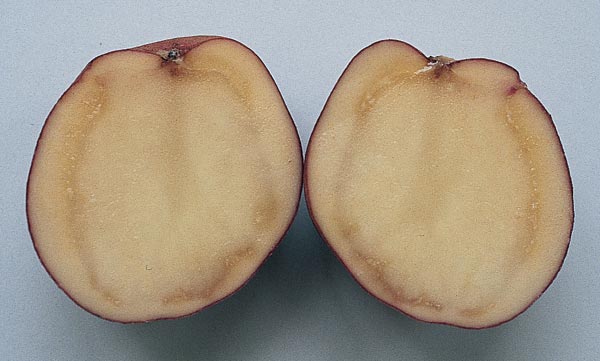 |
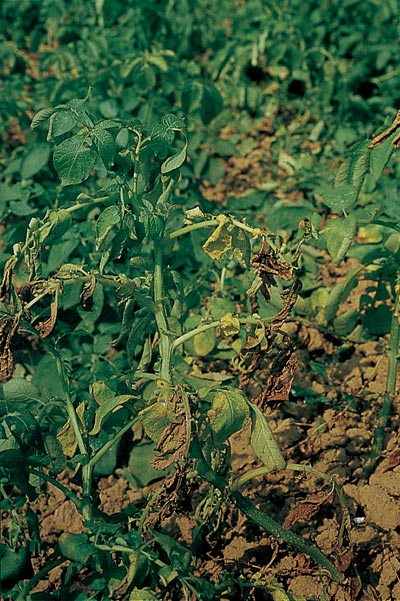 |
|
| Common scab |
Gale commune |
Streptomyces scabiei and other S. strains, e.g. Streptomyces europaeiscabiei and S. stelliscabiei |
Tolerance on the tuber |
Observation of tuber |
Tuber: superficial, corky, irregular-shaped scabs on tuber surface; in severe cases, cracks may develop on the affected surfaces |
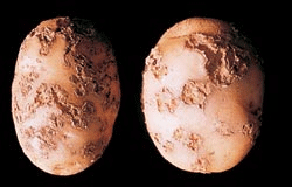 |
|
|
| Netted scab |
Gale plate |
Streptomyces europaeiscabiei and
Reticuliscabiei |
Tolerance on the tuber |
Observation of tuber |
Tuber: superficial netted scabs |
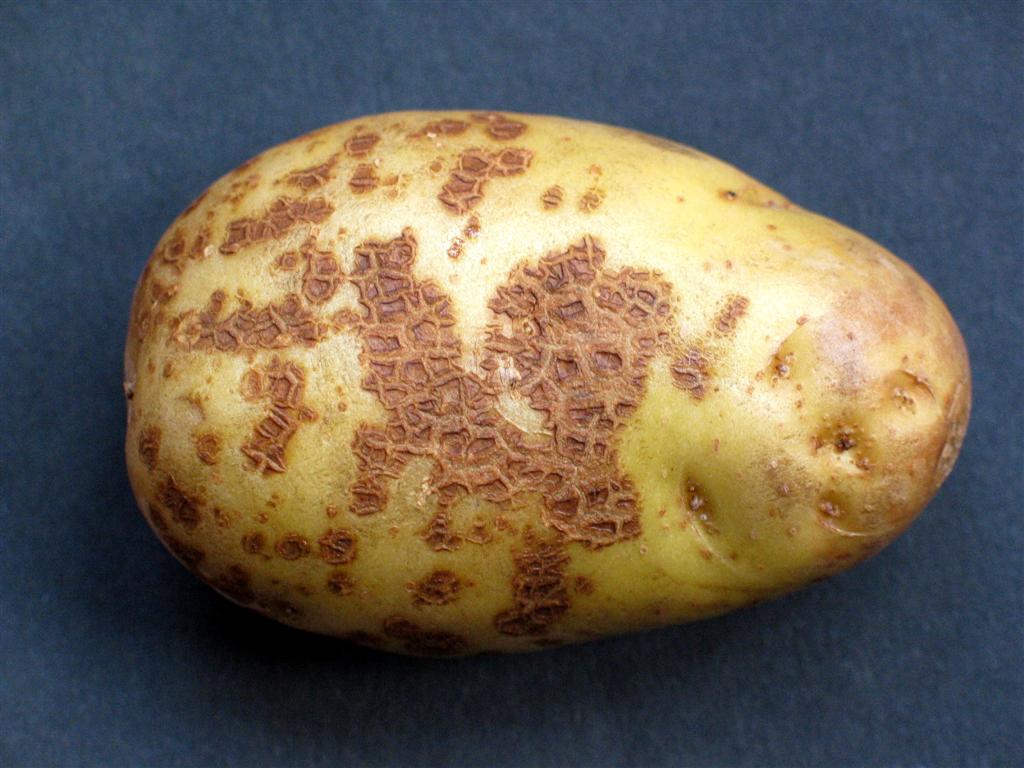 |
|
|
| |
|
|
|
|
|
|
|
|
| VIROID |
| |
|
|
|
|
|
|
|
|
| Potato spindle tuber viroid |
Viroïde des tubercules en fuseau |
Potato spindle tuber viroid (PSTV) |
Zero tolerance |
Observation of plant and tuber. Test by molecular hybridization and PCR |
Tuber: elongation of tuber
Plant: stunting and leaf rolling |
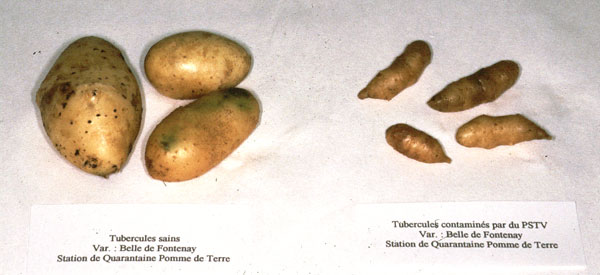 |
|
|
| |
|
|
|
|
|
|
|
|
| PHYTOPLASMA |
| |
|
|
|
|
|
|
|
|
| Stolbur |
Stolbur |
Phytoplasma
[The principal vectors are leafhoppers (Macrosteles spp, Hyalestes spp)]; |
Zero tolerance |
Visual observation of leaves and tubers |
Plant: stunting and leaf rolling |
 |
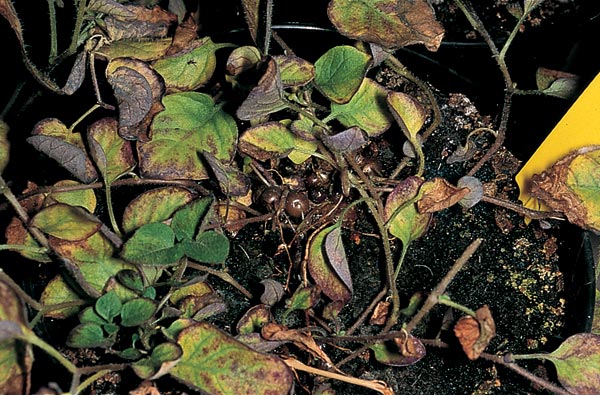 |
In some regions regulated, zero tolerance |
| |
|
|
|
|
|
|
|
|
| NEMATODES |
| |
|
|
|
|
|
|
|
|
| Cyst nematodes |
Nématodes à kystes |
Globodera rostochiensis and Globodera pallida |
Zero tolerance |
Visual observation of the field and testing of soil |
Plant: wilting and death |
 |
 |
|
| Root knot nematodes |
Nématodes à galle |
Meloidogyne chitwoodi and fallax |
Zero tolerance |
Observation of tuber, microscopic examination of cut tuber, and PCR test |
Tuber: surface galls and internal necrotic spots |
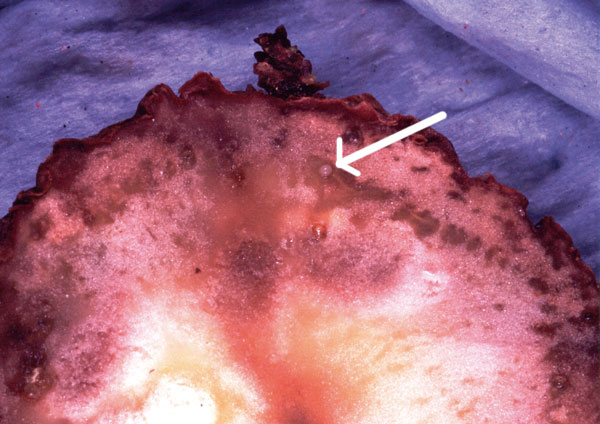

|
|
In some regions regulated, zero tolerance |
| Potato rot nematode |
Nématodes libres |
Ditylenchus destructor |
Zero tolerance |
Observation of tuber |
Tuber: surface cracking and cortical spotting |
 |
|
In some regions regulated, zero tolerance |
| |
|
|
|
|
|
|
|
|
| PESTS |
| |
|
|
|
|
|
|
|
|
| Colorado beetle |
Doryphore |
Leptinotarsa decemlineata |
Unregulated |
Visual observation of eggs, larvae and adults |
Plant: leaf damage |
|
 |
In some regions regulated, zero tolerance |
Wireworms/
slugs |
Taupin |
Agriotes sp.: A obscurus,
A. sputator, A. lineatus/ Tandonia budapestensis, Arion hortensis |
Unregulated |
Visual observation of tubers |
Tuber: tunnels and holes |
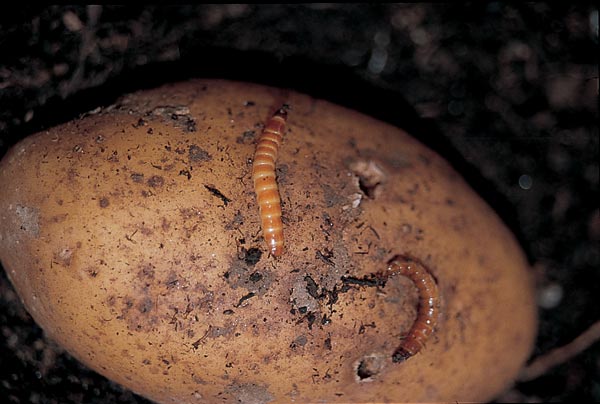
 |
|
|
| Tuber moth |
Teigne |
Phthorimea opercullella |
Unregulated |
Visual observation of leaves and tubers |
Tuber: leaf
Plant: tunnels in flesh damage |

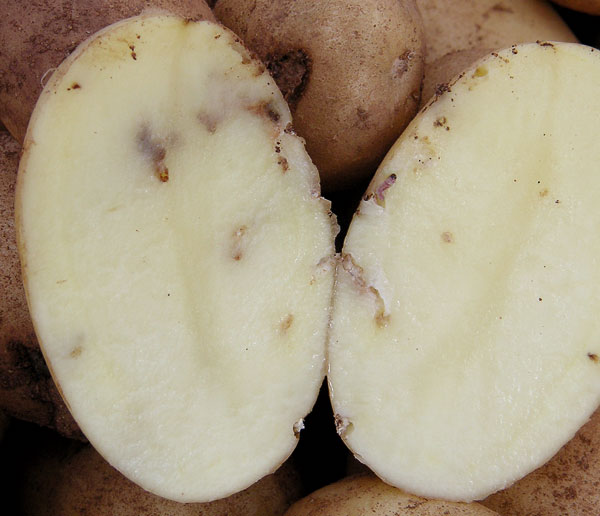 |
|
In some regions regulated, zero tolerance |
| |
|
|
|
|
|
|
|
|